[docxpresso file=”https://www.ancientsunrise.blog/wp-content/uploads/2018/07/How-to-Apply1.odt” comments=”true”]
[docxpresso file=”https://www.ancientsunrise.blog/wp-content/uploads/2018/07/How-to-Apply2-1.odt” comments=”true”]
[docxpresso file=”https://www.ancientsunrise.blog/wp-content/uploads/2018/07/How-to-Apply1.odt” comments=”true”]
[docxpresso file=”https://www.ancientsunrise.blog/wp-content/uploads/2018/07/How-to-Apply2-1.odt” comments=”true”]
[docxpresso file=”https://www.ancientsunrise.blog/wp-content/uploads/2018/07/Employee-Recommendations-1.odt” comments=”true”]

Commercial hair dye companies are slowly learning a painful secret: “Fast, easy, and cheap” has been beneficial for business for just over a century, but will not be sustainable in the coming decades.
The majority of permanent and semi-permanent hair dyes available in stores and used in salons contain para-phenylenediamine (PPD). PPD, a coal-tar derivative dye, was first used as a commercial fur dye until consumers quickly realized that they could use it on their own hair [1]. PPD-based hair dyes entered the market at the turn of the 20th century. Oxidative hair dyes could be made in a range of colors. The products were easy to use and worked quickly. The color result was relatively permanent. These features made PPD dyes very attractive.
Oscar Wilde was one of the first public figures believed to be sensitized to PPD. Repeated exposures, and/or exposures to high concentrations of PPD lead to sensitization and allergic reaction. This can happen to anyone. As with other allergens, a person can be born allergic to PPD, or that person can develop a sensitivity after exposure. Only about 1.5% of the population is born allergic to PPD. The rest are sensitized through exposure. Kligman’s study showed that 100% of subjects developed a sensitization to PPD after five or fewer patch tests of a 10% PPD mixture [2]. Although sensitization rates vary depending on demographics, country, and gender, conservative estimates say around the numbers are around 6.2% in North America, 4% in Europe, and 4.3% in Asia [3].
Prior to 1934, there was no restriction on the concentration of para-phenylenediamine allowed in beauty products. It was even in eyelash tints, which led to corneal ulcerations and conjunctivitis [4]. One such product, LashLure, ended up in an installation at the 1933 Chicago world’s fair called “The Chamber of Horrors.” This installation, set up by the FDA, exposed dangerous products. Although doctors, manufacturers, and some consumers were aware of the dangers of PPD hair dyes from the very beginning, they continue to be sold in the United States. While products containing higher than 6% PPD are now illegal, it is still easy enough to find highly concentrated, powdered PPD hair dye products online and in local ethnic grocery stores. Certain countries such as France, Germany, and Sweden have banned PPD products altogether [5].
An advertisement for hair dye from 1885.
PPD sensitization rates have risen. It is projected that by 2030, about 16% of the western population will be sensitized [6]. This means that fewer people will be able to use oxidative hair dyes and other products containing PPD; hair dye companies will see a loss in their customer base. These companies will also see increased reports of injury, and increasing numbers of lawsuits.
Commercial hair dye companies are now showing interest in returning to a practice that has existed for thousands of years: Dyeing hair with henna and other plant dye powders. For example, L’Oreal recently announced its plans to release a line called Botanea, an all-natural and vegan hair dye line based on henna, indigo, and cassia. Other companies have also produced and marketed henna and plant-based dye products to varying degrees of success.
Whether this “new” return to plant dye powders will be successful to cosmetics corporations will depend highly on the ways they choose to produce and market the product, and how they plan to engage a population which has been dependent on oxidative dyes for so long. Not only will it require these companies to learn the science behind this completely different technique, but to also admit and come to terms with the danger of PPD which they have denied for over a hundred years. Finally, it will also call for the development of henna farms and mills in areas where henna crops will thrive, and the establishment of high standards for exported products.
In the past decades, we have seen a rise in the rate of PPD sensitization. Not only are more people developing reactions to PPD, but their ages are getting younger. This is correlated with the popularity of “black henna” tattoos in tourist areas, as well as the increase of young people using hair dyes [7]. Catherine Cartwright-Jones, Ph.D. explores this epidemic in detail in her dissertation, “The Geographies of the Black Henna Meme Organism and the Epidemic of Para-phenylenediamine Sensitization: A Qualitative History.”
“Black henna” is nothing but a concentrated PPD hair dye mixture, applied directly to the skin. Hair dyes in the United States contain up to 6% PPD. These “black henna” mixtures can contain 25% PPD concentration or higher, enough to sensitize a person within one application. The use of PPD on the skin is illegal in the United States, but “black henna” stalls are very common in tourist areas, and the law is not actively enforced.
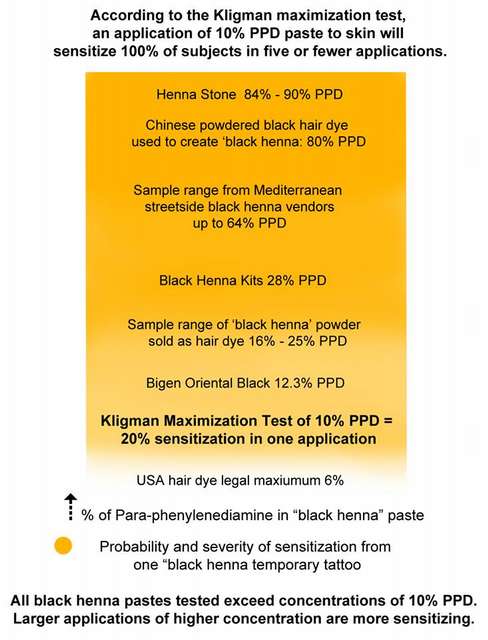
The practice of using concentrated hair dye to create designs on the skin began in North Africa in the 1970s, and by the 1990s it was popular in western tourist destinations such as resorts, amusement parks, and boardwalks. When a child or young adult gets a “black henna tattoo” while on vacation, then, years later, uses a commercial hair dye containing PPD, they can experience a reaction serious enough to land them in the hospital. To learn more about PPD sensitization, read What You Need to Know about Para-Phenylenediamine (PPD).
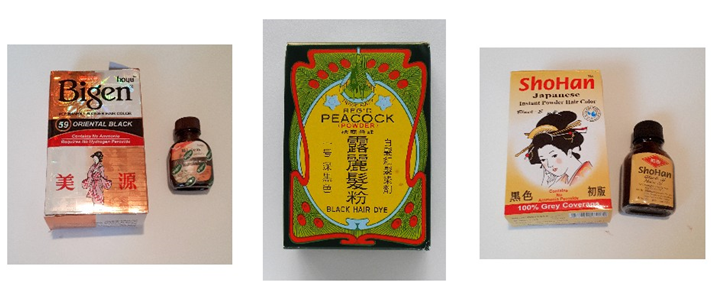
These powdered hair dyes contain concentrated PPD and are easily available online and in local stores despite restrictions.
PPD is also used in printing, the manufacturing of black rubber, and many other industries and products. From the start, doctors and scientists were concerned about the negative effects of PPD and warned consumers of its dangers [8]. However, on November 2, 1934, the FDA struck up an agreement that hair dyes could contain up to a 6% concentration of PPD as long as the packaging contained adequate warning. Since then, the vast majority of permanent and semi-permanent hair dyes sold in stores and used in salons contain PPD.
Here is the exact wording from the FDA:
Under the Federal Food, Drug, and Cosmetic Act (FD&C Act), a law passed by Congress, color additives must be approved by FDA for their intended use before they are used in FDA-regulated products, including cosmetics. Other cosmetic ingredients do not need FDA approval. FDA can take action against a cosmetic on the market if it is harmful to consumers when used in the customary or expected way and used according to labeled directions.
How the law treats coal-tar hair dyes:
What this means is that companies producing hair dyes containing 6% PPD or less, as long as they provide adequate warning and instructions for patch testing, are relatively well protected from injury suits. Despite numerous serious reactions to hair dye, and despite it being well-documented that PPD is a highly sensitizing compound responsible for the vast majority of hair dye allergies, these companies are widely immune to legal repercussions.
There have been a number of attempts at lawsuits and class action suits against certain companies, such as several recent cases against Just For Men. Those involved in the class action suit against Just For Men believed that the company was intentionally targeting men of color in the marketing of their Jet Black dye, which contained a high level of PPD. Other cases posited that the patch test instructions were not sufficient for properly determining sensitivity prior to applying the dye.
The problem with patch-testing is that PPD often causes a delayed hypersensitivity reaction whose onset may not occur until several days after the test. Most patch tests advise waiting 24 hours. Some people experience no reaction following their first application, but have been sensitized to future reactions. This lack of initial reaction leads to serious consequences when that person, unaware of their new allergy, is exposed to PPD again. Many people who experience severe reactions to hair dye had gotten a “black henna” tattoo earlier in their life. In the case of products sold to men for hair and beard use, a consumer may find that they do not react when conducting a patch test on the inner arm, but experience a reaction on their face, where the skin is thin, sensitive, and potentially abraded from grooming.
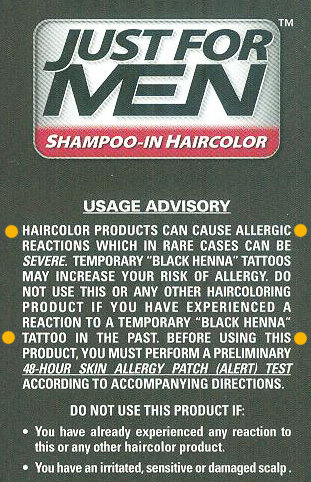
The required warning and patch test advisory on a package of Just For Men hair and beard dye.
Lawyers defending hair dye companies have used PPD’s delayed reaction to their advantage, by insisting that there is no way to tell for sure whether the product caused the reaction, if the reaction did not appear until several days after the customer used the product.
One of the first legal suits against a hair-dye company was that of hairdresser Pauline Karr against Inecto Notox Rapid in 1926. Notox was aggressively marketed as a safe and harmless dye which could be easily applied at home. Despite the fact that companies, consumers, and doctors were already aware of the dangers of PPD, Inecto and other companies did not disclose their products ingredients; at that time, they were not legally required to do so, as the formula was protected as a trade secret.
The dye dripped onto Karr’s finger, staining it black, and she experienced a severe reaction twelve hours later. Karr lost the use of that finger, and sued Inecto. The company won on appeal. Inecto’s lawyers argued that there was no way to prove that the product itself caused the reaction that occurred twelve hours later, and that the company was so large and successful, with thousands of products sold, that there was no way that the dye could be unsafe. Because the company claimed that its formula was the reason for its success, they believed that they were under no obligation to divulge the dye’s ingredients.
This reasoning was used time and time again in following suits. Hair dye companies claim that any injury cannot be reasonably linked to the use of the product itself, and that if any injury does come about from the product, it must be due to misuse on the consumer’s part. Now with the FDA’s stance, hair dye companies are safe from legal repercussion as long as the dye contains 6% or less PPD, and they have adequate warnings on their product labels.
In some rare cases, the plaintiff wins against the company, such as Falk vs. Inecto in 1927. Falk’s lawyer claimed that Inecto Notox Rapid hair dye contained toxic and dangerous substances and that the company was negligent in marketing it as a safe, non-toxic product.
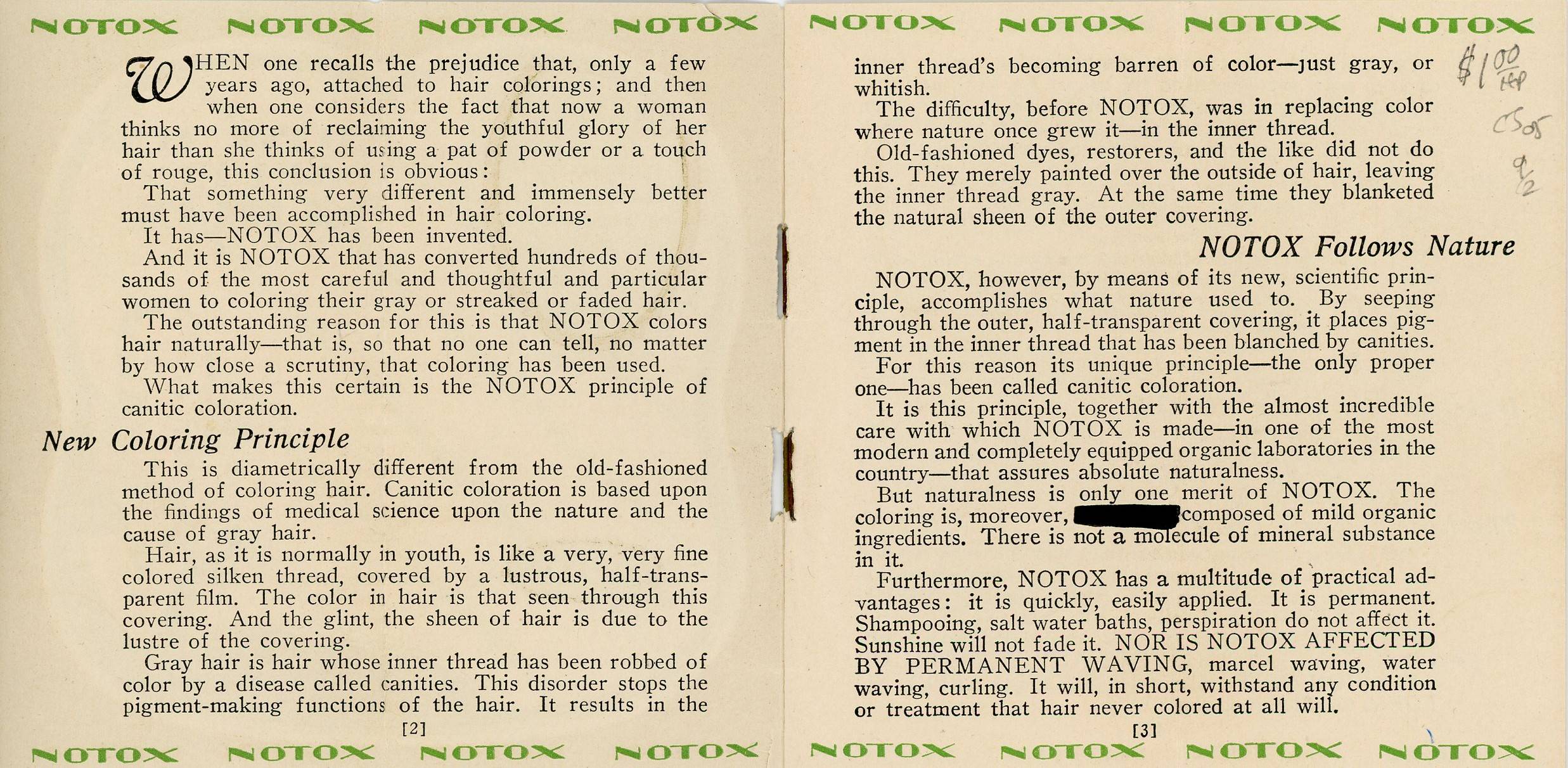
NOTOX “assures absolute naturalness” and claims to be “composed of mild organic ingredients.”
What commercial hair dye companies are not immune to, however, is a loss in customer base. It is projected that by 2030, about 16% of the adult western population will be sensitized to PPD. 7% of the population will experience a reaction serious enough to require hospitalization [6]. People working in industries where they are regularly exposed to PPD, such as hair styling, fur-dyeing, black rubber manufacturing, and printing, are at higher risk of sensitization. Many hair stylists have had to quit after no longer being able to handle hair dyes. Those who develop a sensitization to PPD have it for life, and will experience reactions to products outside of hair dye, which contain PPD or ingredients involved in cross-reactions.
These companies are not ignorant of the facts. They know that people experience reactions after using hair dye containing PPD. They know that sensitization to hair dye is related to “black henna” tattoos. PPD was named allergen of the year in 2006. Scientists and doctors have long studied the connection between hair dye and contact dermatitis, and delayed-reaction sensitization. Despite this, the beauty industry giants hire their own researchers to put out articles insisting that PPD is safe [9].
Henna, Cassia, and Indigo plant dye powders have been used to naturally color the hair for thousands of years. When used in the right ratios, these three plant powders can produce an infinite range of natural hair colors, from blonde to jet black. Henna was particularly popular during La Belle Epoque– the end of the 1800s and the beginning of the 1900s. Artists like Toulouse Lautrec painted women with beautifully vivid red hair. Hennaed hair was seen as sensual and exotic.
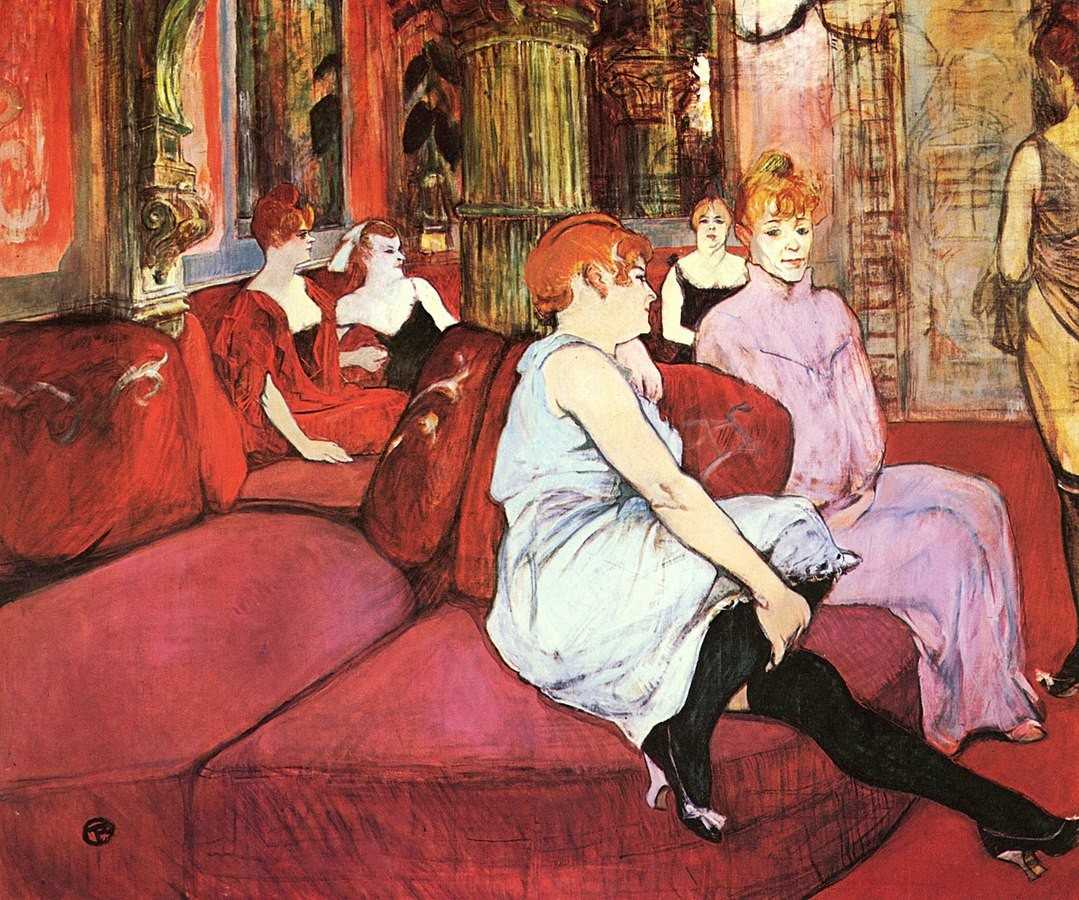
Henna was upstaged by PPD hair dyes during the mid-1900s, as PPD was cheap, easy to use, and provided fast results. Hair dye companies selling henna attempted to make the process easier for the western customer base by creating compound henna products. These products contained metallic salts and other additives meant to alter the color results and make up for low-quality plant powders. As henna powder imports decreased during WWI and WWII, compound henna products were a way to cheapen the product. These additives had nasty effects, especially when oxidative hair dyes or lighteners were applied over hair that was previously dyed with compound henna. Thus, henna’s reputation was sullied. Henna was associated with dirtiness, backwardness, and brassy, orange hair. Many stylists associate still these negative effects with henna itself, rather than the additives contained in compound henna. The use of pure plant powders as hair dye is not taught in cosmetology schools, while the negative bias toward henna is perpetuated. It is common for stylists to refuse to work on hair that has been hennaed.
But the customer base for commercial hair dyes is shrinking as PPD sensitization spreads. Companies have responded by creating and marketing hair dyes that are “PPD free.” These dyes, though they do not contain para-phenylenediamine, use a molecularly similar ingredient instead, such as para-toluenediamine. Para-toluenediamine is another coal-tar dye within the same molecular family. Is still sensitizing, though less so. Whether a person is sensitive to PPD or PTD, cross-sensitization will still occur. This means that many “PPD free” hair dyes are still unsafe, especially for those who have a PPD sensitivity. PPD sensitivities can also lead to cross-reactions with a number of other materials, such as certain fabric dyes, synthetic fragrances, anesthetics,
PPD also goes by a number of different names. Companies may list para-phenylenediamine under a lesser-known name to make their product appear safer. Here are alternative names for PPD:
Other consumers, whether or not they have a PPD allergy, are simply looking for more natural, or “chemical free” products. We are entering an era in which consumers are more health-conscious, more environmentally-conscious, and more wary of large corporations. People no longer want to blindly buy products, but instead choose to do research, read reviews, and read labels. Companies respond by altering their packaging, releasing new products that appear to be healthier, safer, or containing an exotic, natural ingredient. However, there is no regulation on words like, “natural,” or “pure.” Just because a product contains a natural ingredient does not make it any safer. In the same logic, one could add a plant extract to antifreeze and call it “natural.”

An old shampoo advertisement marketing new “exotic formulas.”
Certain cosmetic companies are now looking into attempting what Ancient Sunrise® has done for years: providing pure plant powder hair dye. If done correctly, this change can be a win in the battle against PPD. But the emphasis is on correctly. We have already seen what happens when henna is manipulated with additives for the sake of “cheap and easy.” Henna does not work well with short-cuts. If these companies wish to be successful, they must take the time to understand the art, science, and culture of the natural hair dye world. Failing to do so will result in a waste of time and resources, and potentially an additional blow to the reputation of henna for hair.
What Must Happen For A Successful Transition
Here is what cosmetic companies will need to understand in order to bring henna for hair into the mainstream market:
In their attempts to sell henna, the biggest mistake that commercial hair dye companies fall into time and time again is their attempt to make it quicker and easier to use. They assume that western consumers want simple, quick-fix solutions and are incapable of using a product that requires too many steps.
We have seen the damage that compound henna products have done, both to the hair of the consumer, and to the reputation of henna. Adding metallic salts to henna will not work. “Henna” products that are sold as a liquid or cream are anything but henna. They may contain some henna (or henna extract, whatever that means), but it is unlikely that the plant dye is doing much of the work. Many of these products contain commercial dyes, either coal-tar derived, or azo-dyes. Any natural plant ingredient is there to make the product seem healthier, whether or not the ingredient is even necessary or useful in hair dye. All of the exotic oils, dried flowers, and cocoa powder in the world cannot fix a formula based on bad science.
Because there is no regulation on what can or cannot be called “henna,” these products are extremely misleading to the uneducated consumer. To read more about products claiming to be henna, read Henna for Hair 101: Body Art Quality (BAQ) Henna, Compound Henna, and Hair Dye That Really Isn’t Henna.
Other companies sell pre-mixed powders containing henna, indigo, cassia, and other plant ingredients all combined into one. These products may recommend mixing the powder with hot water. This will not work because henna and indigo require different dye-release processes to work effectively. Henna must be dye-released with a mildly acidic liquid and left at room temperature for several hours before application. Indigo must be mixed with a neutral or slightly alkaline liquid, and used right away. Thus, a pre-mixed product mixed with hot water will yield undesired results, and fade rapidly.
Some companies offer oil-based “bars” that contain henna and other plant dyes, and are meant to be mixed with water and melted down. Again, these products are an example of bad science. Oil prevents the dye molecules from binding to the hair shaft. The result is, again, far from the desired color and quick to fade.
Plant dye powders cannot be mixed. Extra ingredients, either “chemical” or “natural,” are not necessary. The process cannot be sped up. Cutting corners leads to inferior results. Companies must understand that if they want to bring henna and natural hair dye back to the market in an effective and successful way, they must accept that consumers are capable of and willing to learn the science. Ancient Sunrise® has been doing this for years. Its customer base continues to grow. By providing well-researched resources, attentive customer support, and pure, unadulterated plant dye powders, Ancient Sunrise® has built a community of educated consumers who enjoy healthy, PPD-free color.
It will not work to force henna for hair into a one-size-fits-all model. Henna, indigo, and cassia all create a translucent stain on the hair. Unlike oxidative dyes which can lift the hair color with ammonia and peroxide, plant dyes cannot cause the hair to be any lighter. Thus, the result is highly dependent on each person’s initial hair color.
Other factors such as a person’s hair texture and condition, body chemistry, local water supply, and personal lifestyle may also affect color results. Therefore, it will not work to slap a color swatch onto a package and claim that that is the result a customer should expect. While many henna-users achieve their desired results within the first or second try, others will need to adjust their recipes and techniques until they find what works best for them.
Henna is at the center of most natural hair dye mixes. Alone, it stains light hair red, copper, or auburn. Indigo is used alongside henna to create brunette shades. It can also be applied separately after henna to dye the hair black. Cassia adds golden tones and is the primary dye in blond mixes. To learn more about plant dyes for hair, read Ancient Sunrise® Chapter 5: Plants that Dye Hair.
Off-the-shelf home hair dye kits normally contain two or more bottles containing liquids that are to be combined and then applied. The process does not require much thought on the part of the customer. Henna for hair, on the other hand, involves combining up to three types of plant dye powders in a specific ratio to achieve a certain color. These powders must be packaged individually. When companies try to create henna-based products that mimic the easy application process of commercial hair dyes, the results are inferior.
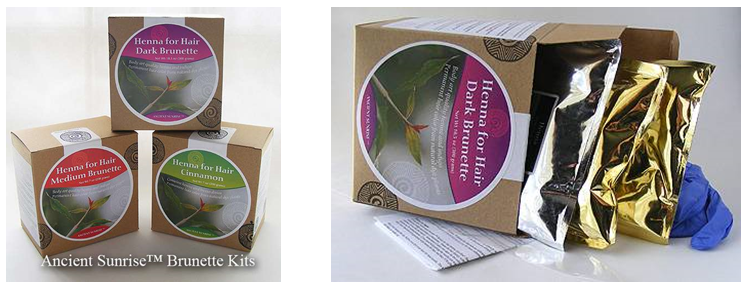
Ancient Sunrise® Henna for Hair kits provide individually packaged plant dye powders at the correct ratios to achieve a wide range of natural colors.
Because individual differences add so many variables to hennaing hair, both companies and consumers must be aware that it takes patience and communication to achieve the best results. If a customer simply picks up a henna for hair product off the shelf, tries it, and doesn’t like the results, they may never try henna again. They might never know why it didn’t work the way they wanted it to, and what they could have done differently to get the result they wanted.
This is why it essential to create a community of knowledgeable henna-users, and to have this community become part of the mainstream hair and beauty culture. Such communities exist for African-textured hair, for people who grow their hair long, for people who abstain from commercial shampoos, and so on. The Ancient Sunrise® Henna group on Facebook is very active and has over 3750 members. This number increases daily. In this group, members share before and after photos, ask questions, and guide each other. When a question is particularly specific or complex, the Ancient Sunrise® customer service representatives act as the “experts”. They are trained in the science of henna for hair in such a way that they can create individualized mix recipes and offer advice, based on an assessment of a customer’s desires, troubles, and hair history.
Henna for hair is not possible without this kind of support system. Hennaing one’s hair was once common knowledge. Now, people may perm, bleach, and color their own hair at home using store-bought products, but they are largely unfamiliar with mixing and applying plant dye powders. Hair stylists have always functioned as ambassadors between the professional world of beauty, and the day-to-day consumer. If henna is to be successful, it will need to be taught to hair stylists in the same way oxidative dyes are taught. The bias against henna must end, and be replaced with more accurate information. If not, misinformation will spread and distrust will grow between stylists, and consumers who have chosen to switch to henna. The following section will suggest ways in which stylists can become leaders in the switch to plant dyes.
Henna’s bad reputation continues to live on through the misinformation taught to and spread by hair stylists. This is not the stylists’ fault. Cosmetology texts contain the same out-of-date information in regards to henna that they have for decades. Cosmetologists come to know this misinformation as fact. The dangers associated with henna come from compound henna, where the culprits are metallic salts, not the henna itself. Compound henna products are, indeed, an absolute nightmare for the hair. Now, many stylists still believe that henna damages the hair, that it coats the hair and makes it brittle, and that the hair cannot be lightened once hennaed. In reality, henna is much safer and healthier for the hair. Oxidative dyes use chemicals to break past the keratin cuticle to deposit dye and to destroy melanin cells, thereby weakening both the internal and external structure of the hair strand [11, 12]. Henna, indigo, and cassia deposit dye that binds to the keratin at the outer layers of the strand, leaving the structure not only intact, but reinforced.
Time and time again, Ancient Sunrise® henna for hair users report that their stylists react negatively upon hearing that they use henna. They will scold their clients and try to persuade them to stop. Some stylists will refuse to work on hair that has been dyed with henna. This is understandable; because of the lack of regulation on products labeled as “henna,” it is nearly impossible to determine if the product the client previously used was truly safe, or whether it would react with other chemicals. While Ancient Sunrise® plant dye powders are all subjected to rigorous lab tests to ensure purity and safety, the same cannot be guaranteed by other brands.
Many stylists, however, see the wonderful color and condition of our clients’ hair and begin to develop an interest in henna. Several stylists are now offering Ancient Sunrise® henna for hair services in their own salons. Some have ceased using oxidative dyes altogether, and work exclusively with henna and other plant dyes. Ancient Sunrise® offers free resources and training, as well as a discount to salons and stylists who use our products in their work.
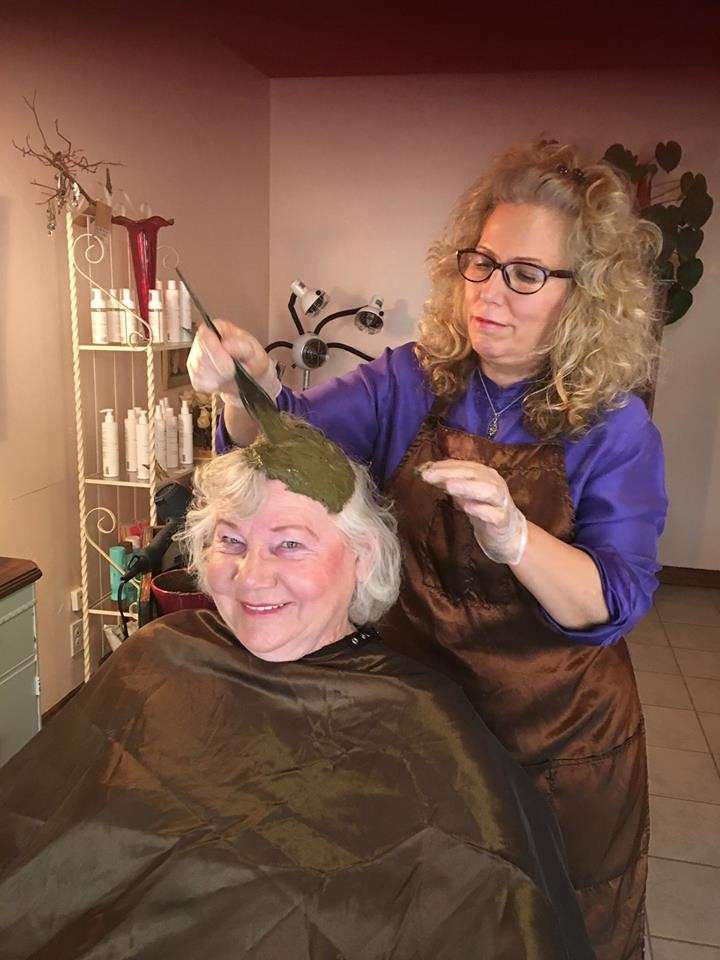
Lisa Marchesi-Hunter offers Ancient Sunrise® plant dye services in her salon in Sedona, Arizona. She and her client have given permission for the use of this image.
PPD sensitization occurs at high rates in the cosmetology industry because stylists expose themselves to hair dye regularly [13]. Many develop such severe reactions that they are no longer able to work as stylists. Henna for hair offers a unique opportunity for stylists who have been sensitized to PPD to continue doing what they love without the risk of allergic reaction. By training stylists in the use of plant dyes, not only will salons be able to offer new services to maintain and build their clientele, but they will be able to employ talented individuals who might otherwise have been forced to find new work.
Stylists have a special and unique relationship with their clients. They connect at a personal level, working with both the client’s appearance and emotions. The clients see them as friends, and also trust their knowledge of hair and beauty. Studies have been done on the use of salons and barbershops as venues for discussing other health issues, such as cardiovascular disease and prostate cancer [14, 15]. It is not absurd, then, to imagine that stylists can have discussions with their clients about switching from oxidative dyes to plant-based dyes, if the client is concerned about sensitization. Now, many doctors who are familiar with the benefits of henna recommend it to their patients who have hair dye allergies. However many of these patients have a hard time finding good products and solid information, and stylists who are willing to help them apply it. It will be of great benefit for more stylists to explore and embrace natural dyes.
The world of beauty is fast-paced, and constantly innovating. Both professionals and customers are quick to pick up on new styles, products, and techniques. Social media helps to spread new trends quickly. While only a few years ago many people would have never heard of the terms, balayage, or ombré, these are now highly sought-after styles, illustrated by thousands of images on the internet and social media sites. Special communities share and discuss techniques for a variety of hair textures and needs. The same is happening now for henna, and must continue into the mainstream, if hair dye companies wish to be successful in selling henna, indigo, and cassia plant dye powders.
This is because the process of dyeing hair with plant dye powders cannot easily fit into a small pamphlet that accompanies a product. The current model of the store-bought hair dye market sets the company as the “expert” of knowledge that is seemingly too complicated for the average customer. The company is trusted to “know what is best” for the consumer, so the consumer can simply buy a product and apply it without question. With henna, a company cannot sell a secret formula; it must provide individually packaged, pure plant powders, along with the correct resources to help the consumer learn how to use them. It is the difference between selling a can of soup, and selling the raw ingredients and a solid recipe.
Henna for hair communities encourage consumers to take knowledge into their own hands. These customers want to know what they are putting on their bodies, and exactly how to create their desired look. They want to know not only how to do it, but how it works and why it works. This new model replaces the instructional pamphlet with active learning and interpersonal interactions. Henna users use resources and each other to perfect their techniques. Passive consumption is replaced with educated consumers making active decisions based on the information they share and seek out.
Where henna was originally used, women spent entire days together at public bathhouses where they would gather to clean themselves, relax, chat, and henna their hair. These techniques were passed from person to person, and from mother to child. Now, as people bathe and groom alone, the internet takes the place as the 21st century bathhouse.
If training is made available to stylists, either through elective additional programs, or within the cosmetology curriculum, stylists can then become trusted experts and ambassadors for plant dyes. This will require that the outdated misconceptions about henna be replaced with up-to-date information. This information is already freely available through Ancient Sunrise®. We have recently designed a training program which can visit salons interested in using the brand, educating stylists on the science and technique over the course of a few days. This program is adaptable to the size and needs of each individual business. The price is dependent on instructors’ time, materials, and travel costs.
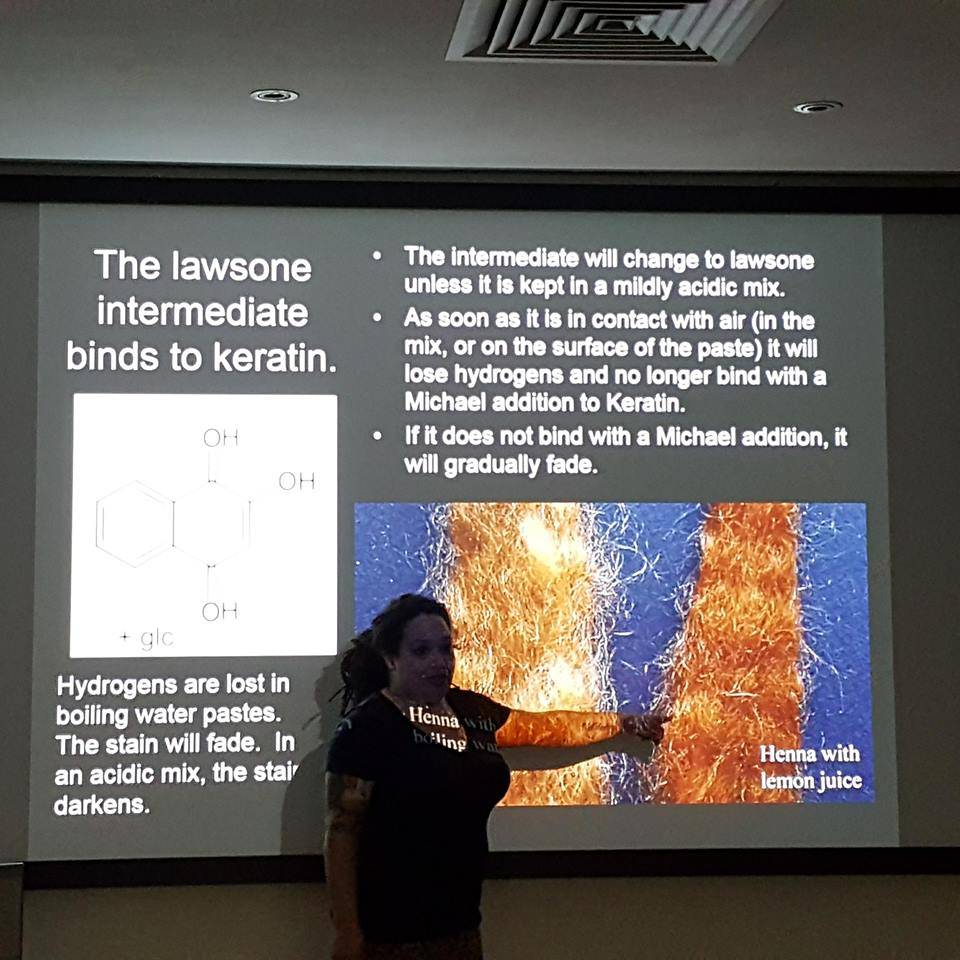
Gwyn presents to a salon company in Italy. Photo credit: Maria Moore
As the more salons begin to offer natural, safe alternatives to PPD-based hair dyes, others will follow suit in order to compete in this new market. It is very likely that, if done correctly, plant-based hair dyeing will become commonplace in the hair styling industry. One day, the use of oxidative hair dyes may be an old-fashioned, backward practice.
If henna is to replace PPD dyes in the western market, there will need to be enough product to meet demands. Ideally, henna for hair should be regulated to ensure quality, consistency, and safety. The product should have to meet a standard for sift quality, as well as a standard for maximum allowable pesticides, added dyes, mineral content, and other chemical adulterants (ideally, this maximum should be close to zero). Quality regulation is essential because the reputation of henna has already been tainted by decades of bad product. Stylists and consumers must trust that these products are safe, that they will not damage their hair, and that they will not interact with other products in destructive ways. Pure henna can be lightened with chemical lightening agents. It can be dyed over with oxidative dyes. Adulterated henna products cannot.
Meeting a high demand for quality product will require the existence of enough farms and milling facilities that operate within the expected standards. Henna is grown in semi-arid climates. Countries such as India, Iran, Yemen, Sudan, and Morocco have grown and produced henna. Currently, the majority of exported henna comes from the Rajasthan area of India. Political, economic, and agricultural factors have caused many countries to decrease production and cease exporting henna. A growth in demand from the western market could greatly boost the agricultural economy of those nations interested in growing and exporting henna.
Henna is a hardy, drought-tolerant crop which does not require pesticides to thrive. The life of a henna shrub is about fifty years. Because only the leaves are harvested, the crop remains in the soil year after year. The plant’s dense, twisting root system prevents soil erosion. Henna is an ideal crop to grow in the southern boundary Sahel desert in Africa, where it can add to the “green wall” project preventing desert spread. As this region has ideal conditions for henna crops, it can present a great economic opportunity for those who live and work there. Building the henna industry there will require working with locals to establish farms and mills, and maintaining quality standards.
Currently, there are no regulations on products labeled “henna” coming into the United States. Much of the henna powder currently sold for hair is poorly sifted, stale, low dye-content henna, with large plant particulates, sand, and other debris. This makes the henna difficult to apply and rinse cleanly. Hair is left tangled and with poor color results. As stated before, many products contain additional chemical adulterants.
Henna is permitted by the FDA only as a hair dye, and not for use on skin. It will be beneficial to legalize pure henna plant powder for all uses and to set up regulations based on lab testing. This way, the United States can ensure that the product entering the country is free of harmful adulterants, and that only products that meet these standards can be sold as henna. These standards should include panels for heavy metals, metallic salts, minerals, and pesticides. Additional testing can regulate sift quality. Legalization and regulation will lead to safer products and wider availability.
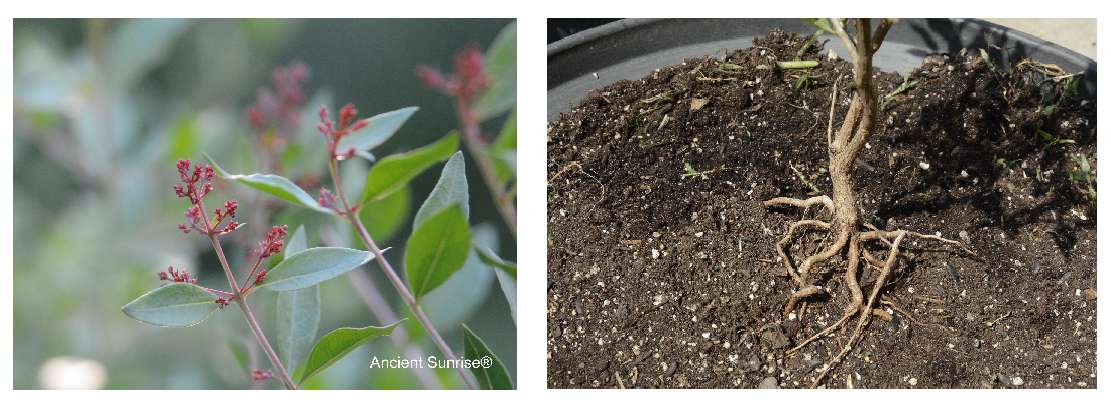
A henna plant and its root system.
PPD sensitization is rising at a rate that will soon make the current hair dye industry unsustainable. A transition from oxidative hair dyes to pure plant dyes within the mainstream market is definitely possible, but it will require earnest effort on the part of those companies which seek to make it happen.
Hair dye companies will have to completely un-learn their previous ideas of what a hair dye is, and what their consumer expects a hair dye to be. They must engage with stylists and consumers to educate them on products and techniques which are far different from what is commonly used today. They must take the time to establish farms and facilities which are capable of putting out high-quality product.
Doing so will allow for more people to dye their hair safely and with beautiful, damage-free results. It will provide alternatives for both consumers and stylists who are sensitized to PPD. It will increase opportunities for economic development in those regions suitable for growing henna, and protect those regions from desert spread. It will prevent future allergies and injuries. Switching to henna is a common-sense, feasible solution, but one that must be executed with the utmost deliberation.
[1] Ashraf, Waseem, Shiela Dawling, and Lew J. Farrow. “Systemic paraphenylenediamine (PPD) poisoning: a case report and review.” Human & experimental toxicology 13, no. 3 (1994): 167-170.
[2] Kligman, Albert M. “The identification of contact allergens by human assay: III. The maximization test: A procedure for screening and rating contact sensitizers.” Journal of Investigative Dermatology 47, no. 5 (1966): 393-409.
[3] Mukkanna, Krishna Sumanth, Natalie M. Stone, and John R. Ingram. “Para-phenylenediamine allergy: current perspectives on diagnosis and management.” Journal of asthma and allergy 10 (2017): 9
[4] McCally, A. W., A. G. Farmer, and E. C. Loomis. “Corneal ulceration following use of Lash-Lure.” Journal of the American Medical Association 101, no. 20 (1933): 1560-1561.
[5] Brancaccio, Ronald R., Lance H. Brown, Young Tae Chang, Joshua P. Fogelman, Erick A. Mafong, and David E. Cohen. “Identification and quantification of para-phenylenediamine in a temporary black henna tattoo.” American Journal of Contact Dermatitis 13, no. 1 (2002): 15-18.
[6] Smith, Vanessa M., Sheila M. Clark, and Mark Wilkinson. “Allergic contact dermatitis in children: trends in allergens, 10 years on. A retrospective study of 500 children tested between 2005 and 2014 in one UK centre.” Contact dermatitis 74, no. 1 (2016): 37-43.
[7] McFadden, John P., Ian R. White, Peter J. Frosch, Heidi Sosted, Jenne D. Johansen, and Torkil Menne. “Allergy to hair dye.” (2007): 220-220.
[8] Wilbert, Martin I. “Cosmetics as Drugs: A Review of Some of the Reported Harmful Effects of the Ordinary Constituents of Widely Used Cosmetics.” Public Health Reports (1896-1970) (1915): 3059-3066.
[9] Nohynek, Gerhard J., Rolf Fautz, Florence Benech-Kieffer, and Herve Toutain. “Toxicity and human health risk of hair dyes.” Food and Chemical Toxicology 42, no. 4 (2004): 517-543.
[10] DermNet, N. Z. “Allergy to Paraphenylenediamine.” (2005).
[11]Ahn, Hyung Jin, and Won‐Soo Lee. “An ultrastuctural study of hair fiber damage and restoration following treatment with permanent hair dye.” International journal of dermatology 41, no. 2 (2002): 88-92.
[12] Sinclair, Rodney D. “Healthy hair: what is it?.” In Journal of investigative dermatology symposium proceedings, vol. 12, no. 2, pp. 2-5. Elsevier, 2007.
[13]Lind, Marie-Louise, Anders Boman, Jan Sollenberg, Stina Johnsson, Gunnel Hagelthorn, and Birgitta Meding. “Occupational dermal exposure to permanent hair dyes among hairdressers.” Annals of occupational hygiene 49, no. 6 (2005): 473-480.
[14] Releford, Bill J., Stanley K. Frencher Jr, Antronette K. Yancey, and Keith Norris. “Cardiovascular disease control through barbershops: design of a nationwide outreach program.” Journal of the National Medical Association 102, no. 4 (2010): 336.
[15] Luque, John S., Siddhartha Roy, Yelena N. Tarasenko, Levi Ross, Jarrett Johnson, and Clement K. Gwede. “Feasibility study of engaging barbershops for prostate cancer education in rural African-American communities.” Journal of Cancer Education 30, no. 4 (2015): 623-628.
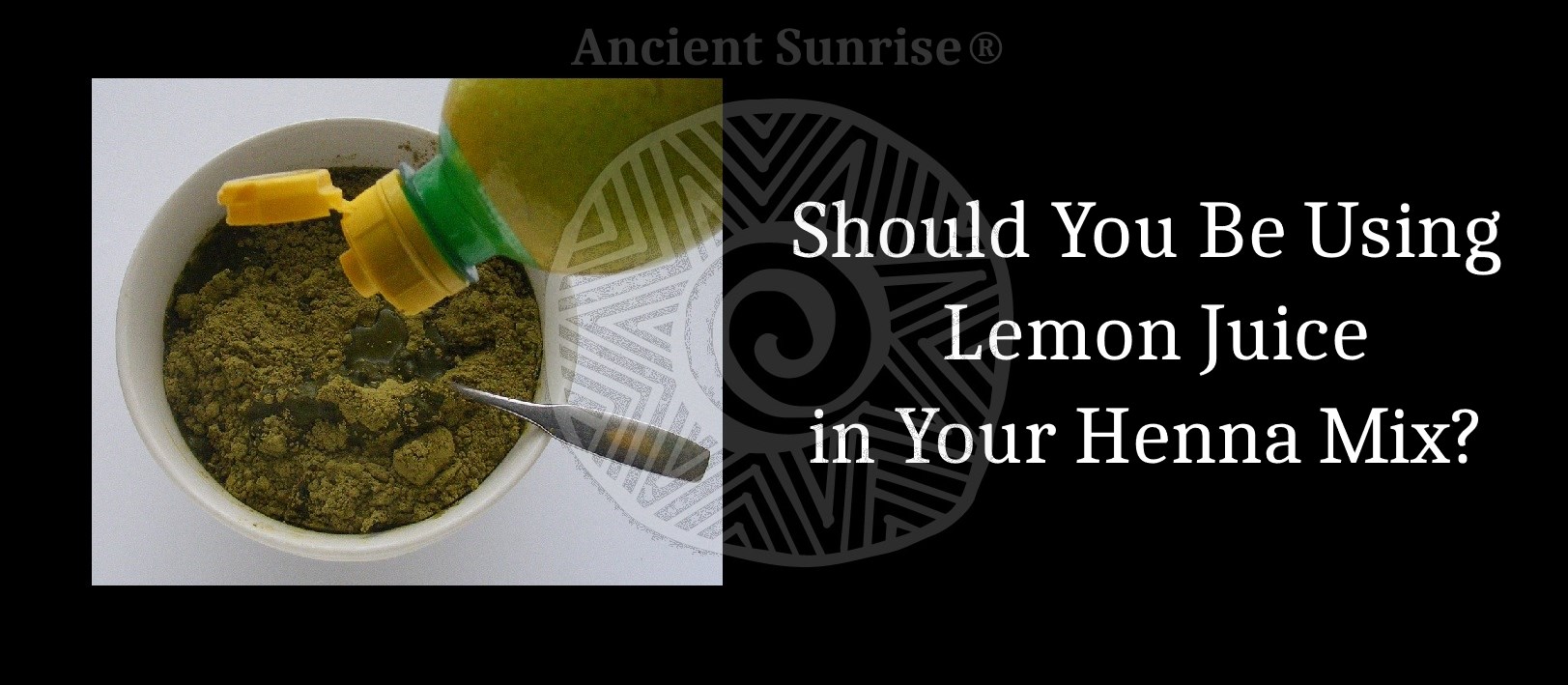
Lemon juice is very commonly used as the acidic liquid for dye-releasing henna. It is cheap, easy to find, and definitely acidic enough for a good dye release. Many people swear by it, but just as many say that they can’t use it. This is because lemon juice can be drying and irritating for many.
In fact, whenever someone asks why their scalp is itching after a henna application, my first question automatically is, “What did you mix it with?” and 90% of the time, the answer is lemon juice. Later, the customer is thrilled to find that, after switching to another acid, they never experience that problem again.
Lemon juice is also often the culprit behind hennaed hair that became darker than desired. A lemon juice mix yields bright orange tones at first, but the stain oxidizes very dark over time.
This is not to say that lemon juice is unsuitable for henna mixes, or that it should be avoided at all costs; for many people, it is just fine. In fact, I use it most of the time in my own mixes. I am not particularly sensitive to it, and the results work for my needs. For others, however, some discomfort or unwanted results can be avoided by choosing a different acid
If you use lemon juice in your henna mix, or are considering trying it, this article will cover a few things you may want to be aware of. You can then decide whether you would rather use a different acidic liquid or powder.
Note on Lime Juice: All of the following applies the same, and more so, to limes and lime juice. Limes are much harsher, and more likely to cause irritation and photo-sensitivity than lemons. Honestly, just don’t use lime juice. If your heart is set on limes, dilute it generously.
As mentioned earlier, lemon juice is a very common cause of itchy scalps post-hennaing. Some people are initially alarmed, and misinterpret this as an allergic reaction to the henna product. While henna allergies do happen, they are extremely rare. Citrus sensitivity, on the other hand, is much more common. To learn more about allergies in relation to plant dye powders, click here.
The low pH of undiluted lemon juice can bother the skin, especially for those with sensitive skin, and especially when henna paste is left on for several hours. The result is dry, irritated skin and rough-feeling hair. The crunchy texture in the hair is temporary, as the cuticles on the hair shaft are raised after a henna treatment, and will settle down in the following days. Cold water and conditioner can help the hair become smooth more quickly.
A henna mix does not need to be extremely acidic in order to achieve dye release. A pH of 4.5 is sufficient. Lemon juice has a pH of 2.3. Consider diluting lemon juice with three or four parts distilled water. Milder juices like apple and cranberry work just as well without needing to be diluted. Ancient Sunrise® offers several fruit acid powders to suit a variety of hair types and needs. Know that each fruit juice or acid powder may yield different effects on the resulting color. Click here for more information on henna and acidic mixes.

Hair may feel rough after henna because dye molecules are settling into place. A very acidic mixture, such as one with undiluted lemon juice, may make this feeling more noticeable.
Lemon juice is a popular way subtly bleach the hair. For those with lighter hair colors, spritzing the hair with lemon juice prior to going out into the sun can bring out highlights. One can also find endless DIY hair treatments involving lemon juice and claiming to lighten hair.
However, using lemon juice in a henna mix has the opposite effect. Lemon juice mixes result in vivid, fiery results at first, but the color is known to oxidize to darker and darker shades over time. I’ve spoken to many people who loved their hennaed hair color at first, but found that it got much too dark over time. The most common mistakes, often used in conjunction, were a) using lemon juice; b) reapplying henna to the entire length of the hair; c) reapplying too often, and d) using heated styling tools. To learn about other causes of darkening and how to prevent it, read this article.

Highly acidic mixes will continue to oxidize after the initial couple of weeks, leading to increasingly dark results after several months or years.
As a rule of thumb, very low pH liquids will all do a similar thing with henna: Initial stains will be noticeably bright, and then the color will deepen continually over time. The more acidic the mix, the greater the difference between first rinse and final oxidation. Many people who use lemon juice may only be aware of the first part, and then later become upset that their hair no longer has that vivid brightness that it once did when they just began using henna. Additionally, the only effective way to lighten hennaed hair is to bleach it.
For a brighter, lighter result that does not oxidize, Ancient Sunrise® Copperberry fruit acid powder works really well. It is high in antioxidants that keep darkening at bay. Ancient Sunrise® Kristalovino fruit acid powder also causes brighter results, and is very gentle on sensitive skin.
Some people (including me), are fully aware that lemon juice causes darker results over time, and use it for that purpose. But to be honest, there are much faster ways to push henna to a deep red without having to wait through the bright orange period. Ancient Sunrise® Malluma Kristalovino fruit acid powder creates deep auburn results and is very gentle on the skin. Ancient Sunrise® Nightfall Rose powder is high in anthocyanins, which gives a cooler tone to henna.
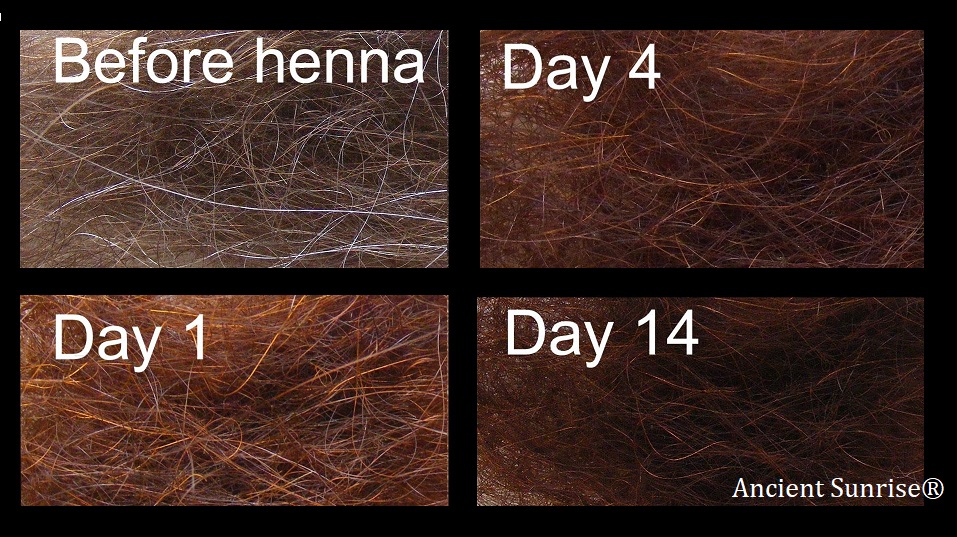
Henna does not fade over time. It darkens. Highly acidic mixes will darken more over time. Mixes that are high in antioxidants can prevent darkening.
Citrus oils are phototoxic. They make the skin more sensitive to sunlight. This can result in sunburns in situations when one would not normally expect to be burned. Especially in the case of fresh-squeezed lemon juice, you may inadvertently cause photo-sensitivity to your scalp by using a henna mix with lemon juice. This is definitely the case with lime juice. You may have heard of people suffering reactions after getting a bit of margarita on themselves while enjoying the sun. This does happen.
On the other hand, henna has some great natural UV protective qualities, and your hair will provide some barrier between your scalp and the sun. In any case, if you have particularly photosensitive skin, or are sensitive to citrus juices and oils, you may want to consider using a different fruit acid.
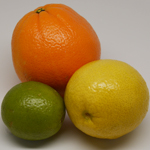
Lemon juice will always be a staple in the henna world, but it’s always good to have options. As I mentioned before, there are numerous other fruit juices and fruit acid powders which will work just as well, or better, than lemon juice.
If you’re set on using lemon, consider diluting it. Full-strength lemon juice is more acidic than what is necessary to dye-release henna. As long as the liquid tastes mildly tart, it will work. Diluting also makes your bottle of lemon juice last longer, or saves you from having to squeeze several pounds of lemons.
If you are experiencing an irritated scalp, try one of the Kristalovino fruit acids, or apple juice. Ancient Sunrise® Malluma Kristalovino is the gentlest of all of the Ancient Sunrise® fruit acid powders, and makes henna shades darker for rich auburn and brunette shades. Ancient Sunrise® Kristalovino is the second gentlest, and leaves results light and bright. Apple juice is mild, and will result in a tone that is neither too light nor dark, but can be sticky and make your mix smell boozy.
If you are looking for bright, coppery or fiery tones that stay bright over time, try Ancient Sunrise® Copperberry fruit acid powder, or pure cranberry juice. Both are high in antioxidants that prevent the henna color from darkening over time. If you opt for cranberry juice, make sure to get the real thing—many are a mixture of other juices, water, sugar, and some cranberry juice. 100% pure cranberry juice can be expensive, though.
Lemon juice is a great mixing liquid for some people; for others, it can cause issues. Be aware of this if you are new to mixing henna, or if you are mixing henna for someone else. If you are experiencing an itchy, irritated scalp, or if you notice that your hair color is getting too dark over time, consider using a different dye-release acid. You will very likely find that lemon juice is the culprit. Again, the same goes for lime, which is even more acidic and phototoxic than lemon. Lemon juice at full strength can be tolerated by some. Lime juice should always be diluted, and better yet, avoided.
If you have any questions about what acidic medium to use in your henna mix, feel free to comment below or contact Customer Service at www.Mehandi.com.
Author Rebecca Chou May 2018
Edited Maria Moore November 2022
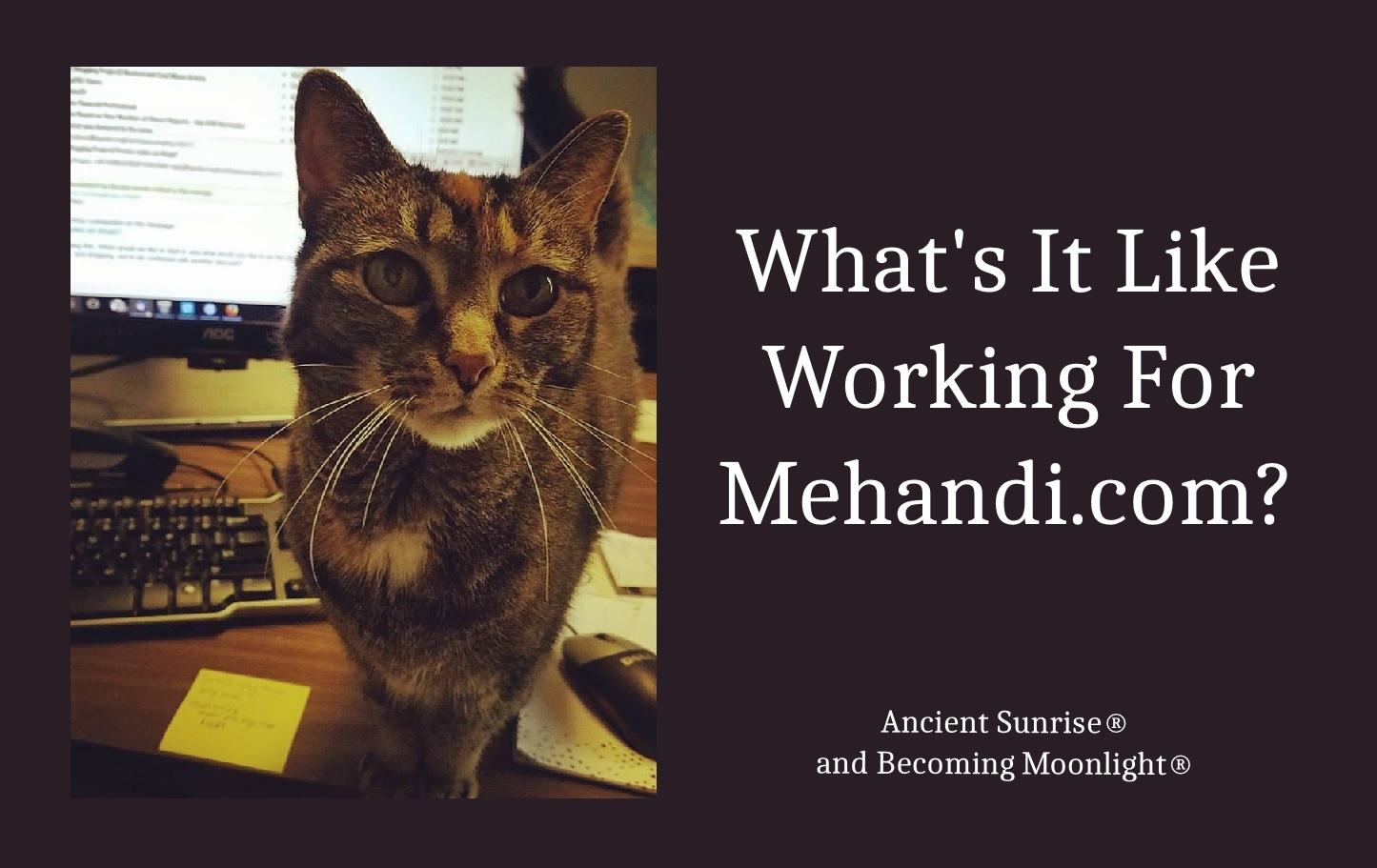
Writer’s Note
Ask any employee here, and they’ll agree that there is no company quite like Mehandi. Probably because there is no boss quite like Catherine Cartwright-Jones, PhD.. I have worked for Mehandi and our branches for almost three years now, and it is truly wonderful and different. Before starting the blogs this past summer, and moving to Montreal, Quebec, I was part of the Customer Service team in the main office, worked at our brick-and-mortar store, Empire, and was a “body art specialist” for the company. Before that, I was a customer who loved the products.
What makes this company different is its openness and flexibility. Part of it is cross-training, and part of it is that the company recognizes staff’s talents and interests, encouraging them to take on new roles. If I were to write down my job description, it would be long and strange. When people asked me what I did, I’d stop for several seconds, because “Customer service for an online store” did not capture it in the very least. I’d need an hour to give it justice, starting by describing Catherine’s research on henna for hair, the dangers of PPD, and the use of body art throughout history and around the world… and how the company came about in relation to that research… and how we didn’t just sell things but also provided information and support… and yeah I was on the phone a lot, but sometimes I was covering myself or others in glitter… and sometimes I was doing research… and sometimes I was playing with puppets.
Now, I’m here in my office, in my apartment hundreds of miles away from Kent, Ohio, but still very much connected to the company through the magic of the internet. For this article, I drew on my own experiences and asked my co-workers to provide their own thoughts. One thing becomes very clear: It’s all about the people.
The Warehouse
First, I’d like to take you on a descriptive journey through the little blue building we call The Warehouse. Just off the highway, on Tallmadge Road, in Kent, Ohio, down a gravel driveway, hidden behind another industrial building, there is a place where magic happens on the daily. There are hummingbird feeders attached to the windows. Jenny the cat, who has been out stalking some small thing, is rolling on the sidewalk leading up to the door.

The warehouse. Photo credit: Roy Jones
Walk inside, and you are greeted with a swirl of scents. It has the classic odors of a warehouse and office space, with its notes of cement, dust, and cardboard. Then, you smell plant powders and spices. Shampoo and soap bars. Incense, which many employees burn in their offices. Burnt sage, if some negative energy had to be dispelled recently. If Lynnette, head of Assembly, has been packaging essential oils, that heady smell hits you square in the nose.
You are standing in the Assembly room. Here, packets are labeled, fruit acid powders are measured and bagged, and henna-for-hair kits are put together. To the right, Lynnette’s office is dimly lit with hanging lamps and smells like a temple. Her office is also the home of one of our printers, whom we call Hal. Hal prints our labels and other things needed for assembly. Val is the other printer.
Walk forward into the next room, and you are in Packing and Shipping. The walls are lined with shelves holding henna for hair kits and big baskets of individual plant dye powder packets. There are drawers full of shampoo bars, soap bars, and smaller items. There are wide tables where Michelle or Melissa are stacking shallow black bins, each containing the contents of an order ready to be packed and shipped. They double-check the order form and initial it. When an order gets packed, it’s checked and initialed again before the box is taped up. Carl the cat is most likely snoozing under the shipping table.
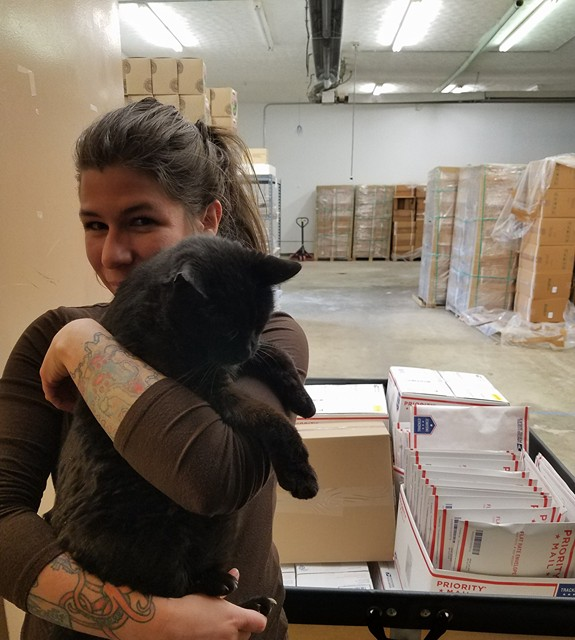
Melissa and Carl wait for the mail truck.
Through the door straight ahead is Customer Service. Be quiet and keep the door closed. Here are several desks with computers, each area personalized by each customer service representative. The walls are covered with fabric tapestries, hair swatches, letters and photos from happy customers, and cheat sheets for item codes, mix ratios, and other important information. The CSRs are chatting through their headsets and typing on their keyboards. If the phones are slower, they are answering emails, or responding to posts on our Facebook pages.
A door on the other side of the Customer Service office leads to a hallway. Here are the doors to the offices of the administrative positions. Roy Jones, Catherine’s husband, is the man behind anything having to do with technology. He also does photography for promotional materials. His office is tech’d out and filled with books about computer systems and coding. Other administrative positions have offices in this hallway, as well. Val, our other printer, spits out customer order sheets in the corner.
The Packing and Shipping room is also attached to the warehouse proper, as well as the break room. The warehouse contains huge pallets of boxes filled with henna, indigo, and other plant powders, which we ship from India several times a year. It is dark, quiet, and cool.
The break room is a wide space that holds a large, comfy couch, shelves of packaging materials and office supplies, and a dedicated space for photography. Someone may be having lunch or catching a quick nap while others prepare a body art piece for shooting. There is a shelf full of fabrics and props. The couch is eternally covered in glitter. This is where we have company meetings. Some of the staff will pile on the couch, others will bring in their chairs, and others sit on the floor. The cats will wander from person to person, demanding their due pats.
There are no cubicles here. The furniture is a mix-and-match of used and re-purposed items. There are several very old, very pretty rugs. The whole place looks like it is run by a hippie who went into business, and who has a penchant for digging through Craigslist for antique furniture. Because maybe it is. Catherine works from The Shed, her office at her home, and pops in from time to time. But her presence here is always clear. The warehouse is a home, and the people are a family. We joked among ourselves that the type of person to work here is always a little weird, and maybe you have to be, to be this passionate about something like henna.
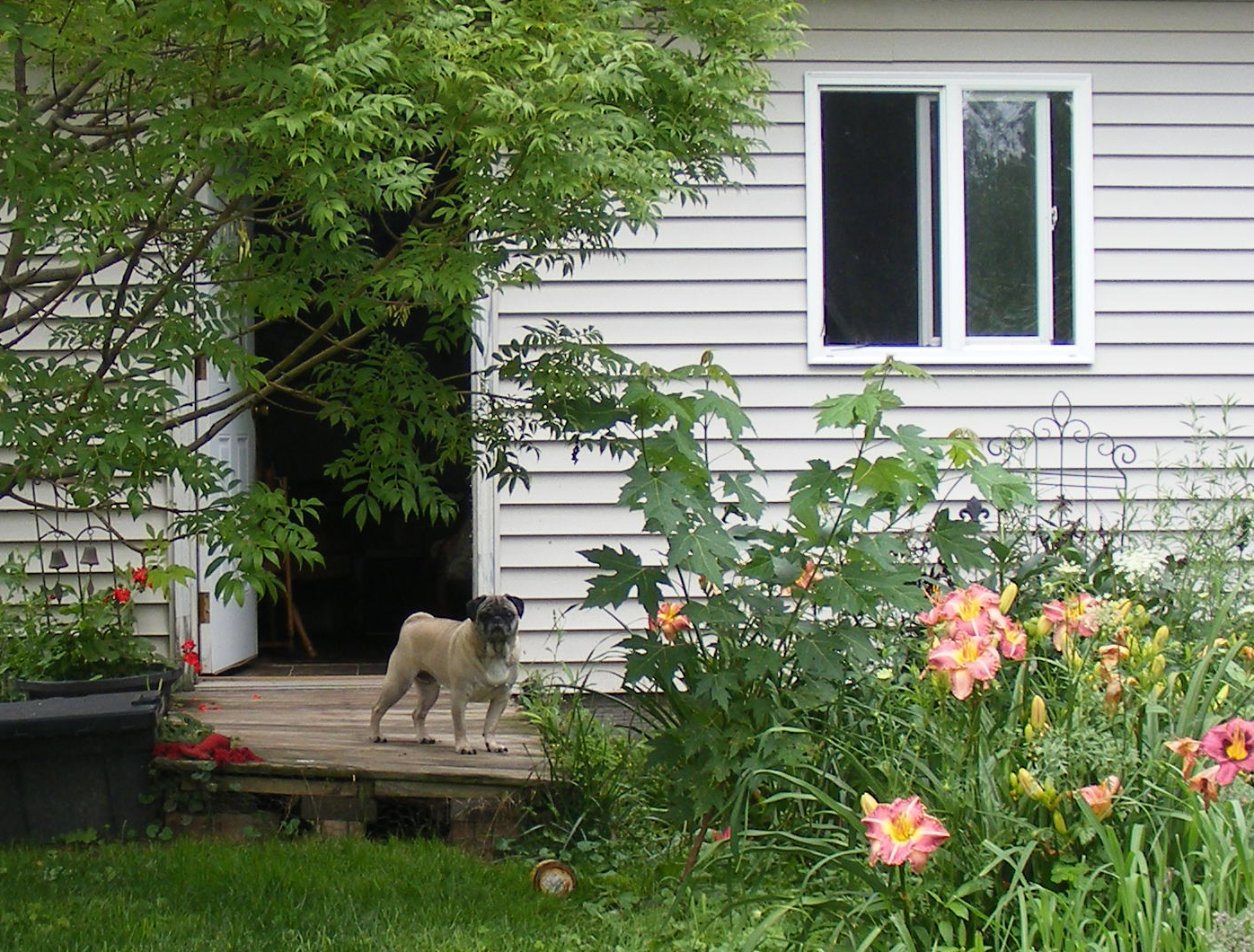
Rumple guards the entrance to The Shed. Here is where Catherine completed her PhD Disseration.
What is Mehandi.com?
Mehandi is the online store for Ancient Sunrise® hair and skin products. It is the result of years of research by Catherine Cartwright-Jones, PhD., who had an interest in providing safe alternatives to commercial hair dye and providing research-based information on henna. The company’s origins go back to the Henna Page Forums of the mid-to-late 1990s when henna began to gain popularity in the Western world.
We ship across the globe. HennaforHair.com, Hennapage.com, Tapdancinglizard.com, and our blogs continue to publish scholarly and research-based information that is free to the public.
Catherine’s vision went beyond selling a product. It was about educating the consumer and shedding light on safe, effective methods of hair care and body art. Catherine has spoken to the FDA and to cosmetic giants about the epidemic of para-phenylenediamine (PPD) sensitization. She hopes to influence change in the use of PPD in hair dyes and to bring henna for hair into the mainstream. Mehandi.com has tens of thousands of customers who now happily color their hair without risks of allergic reaction or hair damage.
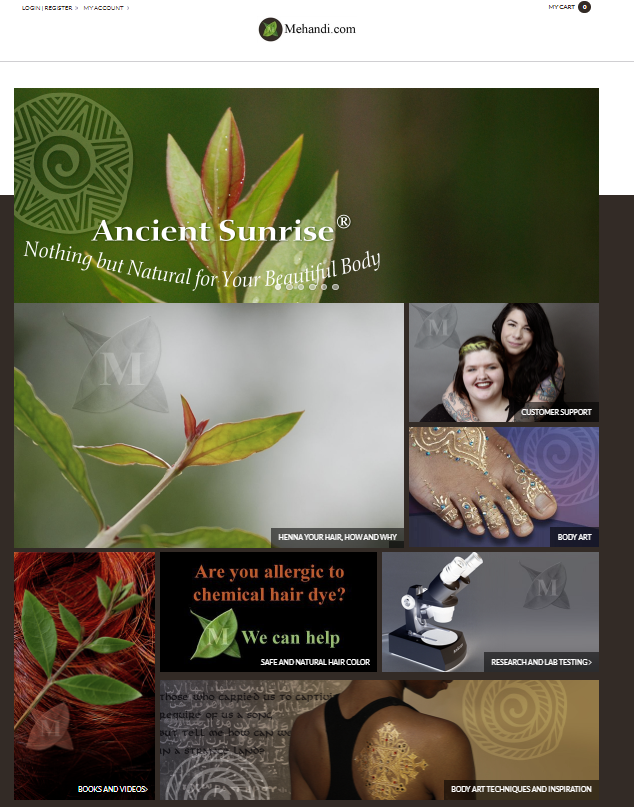
Our new and improved website launched in 2017.
Happy Staff = Happy Customers
Catherine firmly believes that the success of the company depends on the way her employees are treated. She knows that work can be stressful and that the staff spends much of their time at The Warehouse. Therefore, work should be a comfortable and enjoyable place. Our kitchen is stocked with coffee, teas, and healthy snacks. There is a request sheet that is filled regularly. Out of chocolate-covered almonds? Put it on the list. Snacks are part of the company’s budget. Roy regularly treats the staff to lunch. If a company meeting is happening, there will probably be food.
In addition to staying well-fed, we are quite comfortable. There is no dress-code policy. Staff are encouraged to wear whatever is most comfortable for them, whether it is jeans, pajama pants, or flowing skirts. Some shuffle around in fluffy slippers. There are a number of seat options available, so whether a person prefers a swiveling office chair or a yoga ball, there is something that will work. The large sofa in the break room is great for naps. The two office cats, Carl and Jenny, who keep us company, provide stress relief, and lie on our keyboards at inopportune times.
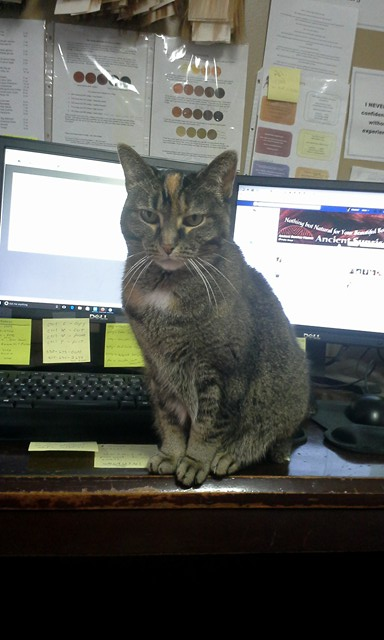
Jenny is very good at getting in the way. Photo credit: Elizabeth Nissel.
Customer Service
Our commitment to customer service is what makes this company great, as well as unique. I don’t mean it in that cheesy-commercial-slogan kind of way. Catherine understood that the knowledge of using henna was once commonplace because it was shared among family and friends. In the areas where henna was traditionally used, men and women went to their respective public bathhouses, and communal spaces to wash, groom, and interact with others. People washed each other’s bodies, hennaed each other’s hair, hands, and feet, and shared grooming tips. Now that personal hygiene has moved to the privacy of individual homes, Catherine understood that, in order for this knowledge to be spread again, she had to create a modern version of this community.
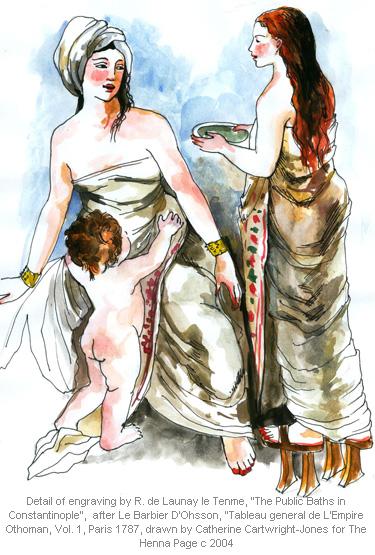
It starts with the customer service team. Each new representative takes the time to read the Ancient Sunrise Henna for Hair E-book and many other resources before being able to work one-on-one with customers. The other team members help each other to make sure that the info they are giving out stays accurate. When needed, the staff re-read material and find new articles to share with one another to keep their knowledge fresh. New members are quizzed on their knowledge by their co-workers. They role-play potential phone calls and give constructive criticism. It may be several weeks before a trainee is allowed to take a phone call on their own; they begin with emails and responses on social media which are checked by Maria, the Customer Service Supervisor, before being sent. This is all to make sure that our customers get consistent and accurate information.
The customer service staff communicates with customers in several ways: By phone, email, online chat, one of our many Facebook groups and pages, and through social media programs like Instagram and Twitter. We also send out a monthly newsletter. The customer service office is open much later than an average business—often until 10pm EST on the weekdays—so that people can contact them late in the evening for last-minute orders, questions, or advice.
Customer Service advises henna users on custom mixes and selecting the products that work best for them. They take orders. They troubleshoot. Being a customer service representative is both stressful and rewarding. It requires an amazing amount of multitasking. Jumping from a phone call to a chat session, to a Facebook thread is a normal part of the job.
We know many of our regular customers by name and even their usual order. CS keeps notes on customers’ files, so if a customer has been working on adjusting their mix, or has been having difficulty achieving their desired color, any representative can pull up their history and continue the conversation where it left off last. (Here’s a secret: We’ll also write notes like “This person is so sweet and a joy to work with!”)
Because of this, we are able to develop a personal connection with our customers and grow a community of henna users who are well-versed in henna for hair. Our online community at the Ancient Sunrise Henna group on Facebook is now well over 3,500 members and is very active. Customers are able to ask each other for advice and to share photos of their hair. The group is like our virtual bathhouse, and the CS representatives, Catherine Cartwright-Jones, and I are like the grandmothers, sitting quietly in the corner until someone needs a little help.
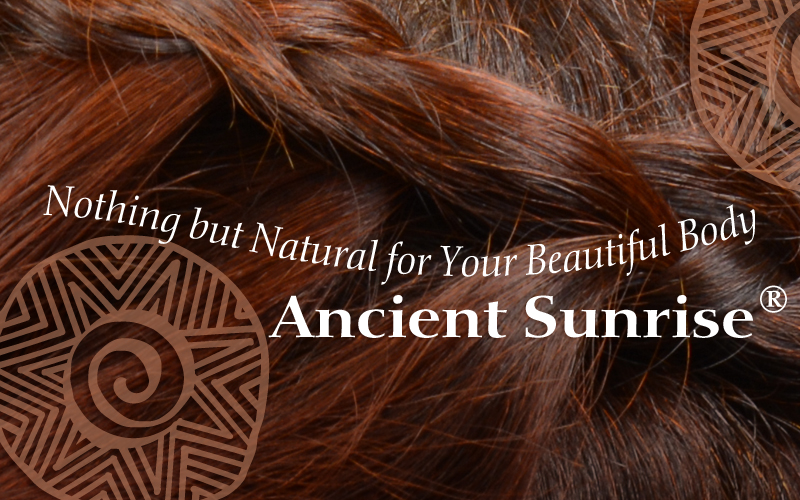
If you’re not yet part of our public Facebook group, join now!
Of course, henna knowledge then spreads in real life, through families, friends, co-workers, and even strangers. This company does very little in the way of advertising; many of our new clients call us after being introduced through word of mouth. In fact, there have been numerous times when a new customer told me that they are calling because they had stopped someone on the street and asked about their hair. Customers regularly report that they are asked about their hair. This happens so often that, by customer request, we began adding an extra business card to each of our shipments.
It is exactly this kind of community that Catherine envisioned when she began Mehandi.com. Her goal was not only to provide quality product, but also the knowledge and support that would allow henna to become a regular, household practice again.
Cross-Training and Interdepartmental Magic
Because we are a small company, many of us wear several hats. When I was living in Ohio, I worked in the Customer Service office during the week, and at our brick-and-mortar store, Empire, on Fridays and Saturdays. I, like many others, was also trained in Shipping, where we pick and pack the items that go out all around the world. I also helped out in Assembly, where the products are put together. I liked to measure the powders for the Henna for Hair Kits, and stick labels on the packaging. At one point, when the bakery and chocolate shop, Bittersweets, was short-staffed, a few of us also filled in there to help at the register and to clean chocolate molds. During the winter months, some of us do body art, hair, and/or make-up for promotional materials and tutorials, and other staff members act as our models.
Because most of the staff has experience in several departments, we understand how other departments work. This makes it easier for someone in Customer Service to know what is possible for Shipping, or for Inventory to check on how much time Assembly will need to create more stock. Because the space is relatively small, it is easy enough to run over to the next room to ask someone a question related to their department. Having a small crew of knowledgeable and flexible staff makes everything flow smoothly.
Communication and Collaboration
In addition to the comfort of the physical environment, the feeling of openness and respect extends to the way that we are able to communicate and be heard by those in charge. Company meetings invite brainstorming and collaborating on new ideas. When asking my co-workers for input about this article, many of them said that they feel respected and that their ideas are heard. I wholly agree. One of my favorite parts about working for this company is that creativity is appreciated.
In fact, these blogs came about because a few months prior to my move to Canada, I mentioned that the blogosphere seemed like a place where we needed a stronger presence. This turned into Catherine’s decision to launch AncientSunrise.blog and BecomingMoonlight.blog, and have me write while in Montreal. It was wonderful that she recognized my knack for research and writing, and turned it into a way to keep me with the company.

My home office in Montreal, in its natural state of chaos.
Photography and video happen by the bookcase; research happens all over the desk and floor.
Other products of staff creativity include our Instagram accounts, video tutorials, and ideas for promo codes. The Customer Service staff propose events for promos, and create those fun announcements you see on our Facebook pages. We are also listened to when we feel something is not working smoothly. In 2017, when the new Mehandi.com website was launched, Roy gave everybody access to the site in progress so we could check the pages and provide input and corrections.
It’s wonderful to work for a company that recognizes its employees as creative and skilled people with ideas worthy of being heard. We can say, “I would like to try this” and the response is more often than not, “Great idea! Go for it!” We know that our co-workers will be excited to see the outcomes of our ideas, contribute suggestions, and give constructive criticism. With so many projects happening at any given time, work never gets old.
Our work takes us around the world and in front of big audiences, too! In 2016, Catherine presented to the Office of Cosmetics and Colors at the USFDA, and then later that year at The IFSCC, International Federation of Societies of Cosmetic Chemists. In spring of 2017, Maria and Gwyn spend a week in Italy, working with a salon interested in incorporating henna into their services and products.

Catherine Cartwright-Jones speaking to members of the USFDA. Photo credit: Roy Jones
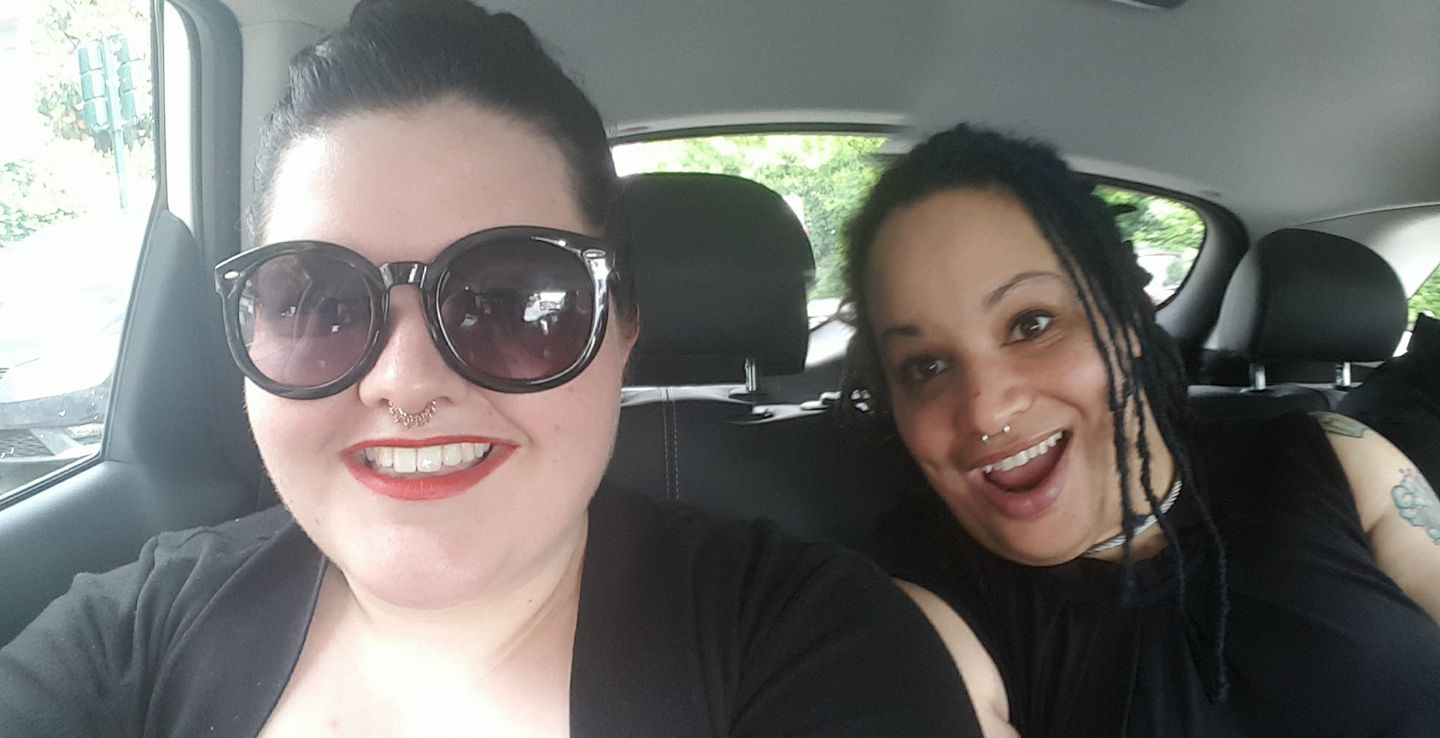
Maria Moore and Gwyn Jones in Italy. Photo credit: Maria Moore
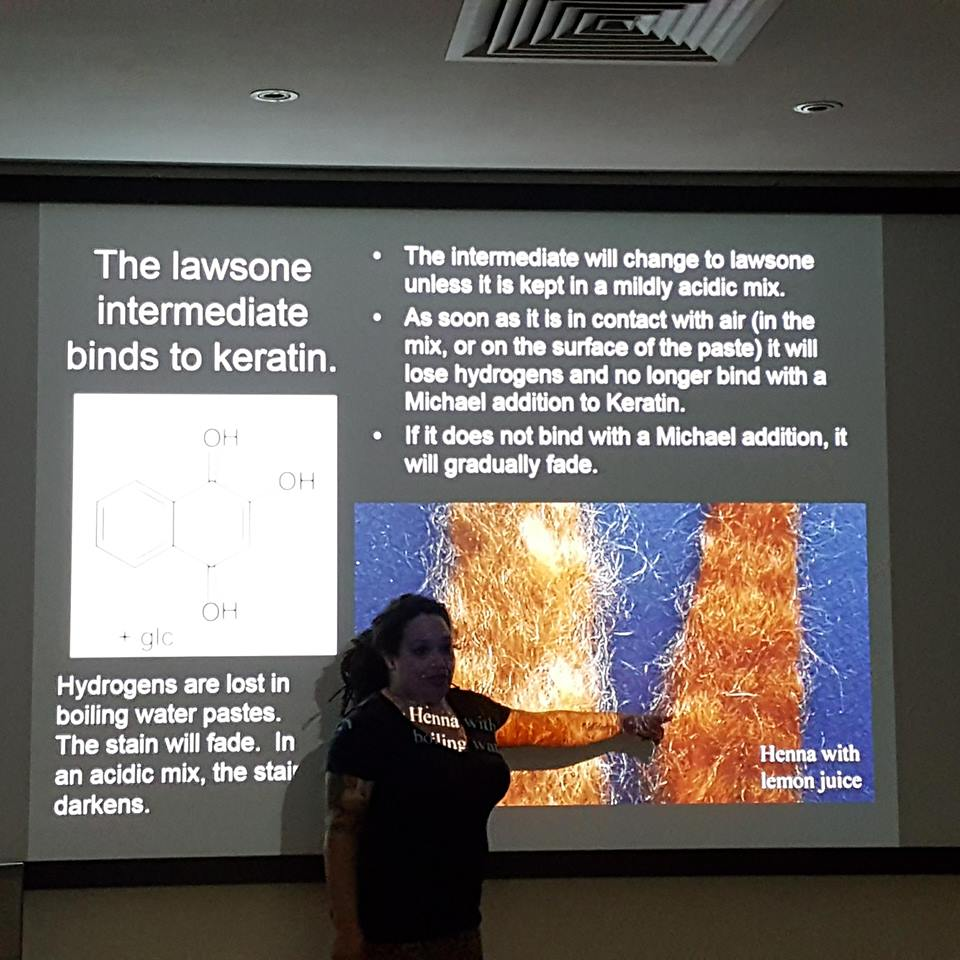
Gwyn presents to a company in Parma, Italy. Photo credit: Maria Moore
We Are a Family Company in Every Sense
Catherine’s husband, Roy, oversees day-to-day operations and decision-making at the office. Gwyn, Catherine and Roy’s daughter, knows everything there is to know about importing and customs. Catherine’s son, Rhys, is an attorney who helps with legal matters. Mehandi is very much a family-run business.
But the staff’s family matter, too. When I asked my co-workers for input for this article, one of the responses I repeatedly received was how much they appreciated the flexibility they had when it came to taking care of their own families. Many members of the staff have children of different ages and needs. They are able to adjust their schedules when situations arise. Because our jobs are so fluid, it is often possible for one person to fill in for another across departments when needed. Staff members sometimes bring their children to work during school breaks, or on days when school is canceled. In fact, the employees’ children love to play with each other. Jen’s daughters are great models for body art, sitting still while having their hands or faces painted. They have been featured in many of our promotional photos. Maria’s son has also had his face painted his fair share of times.

Staff kids at the office during the winter holidays. Photo credit: Jenifer Jeney
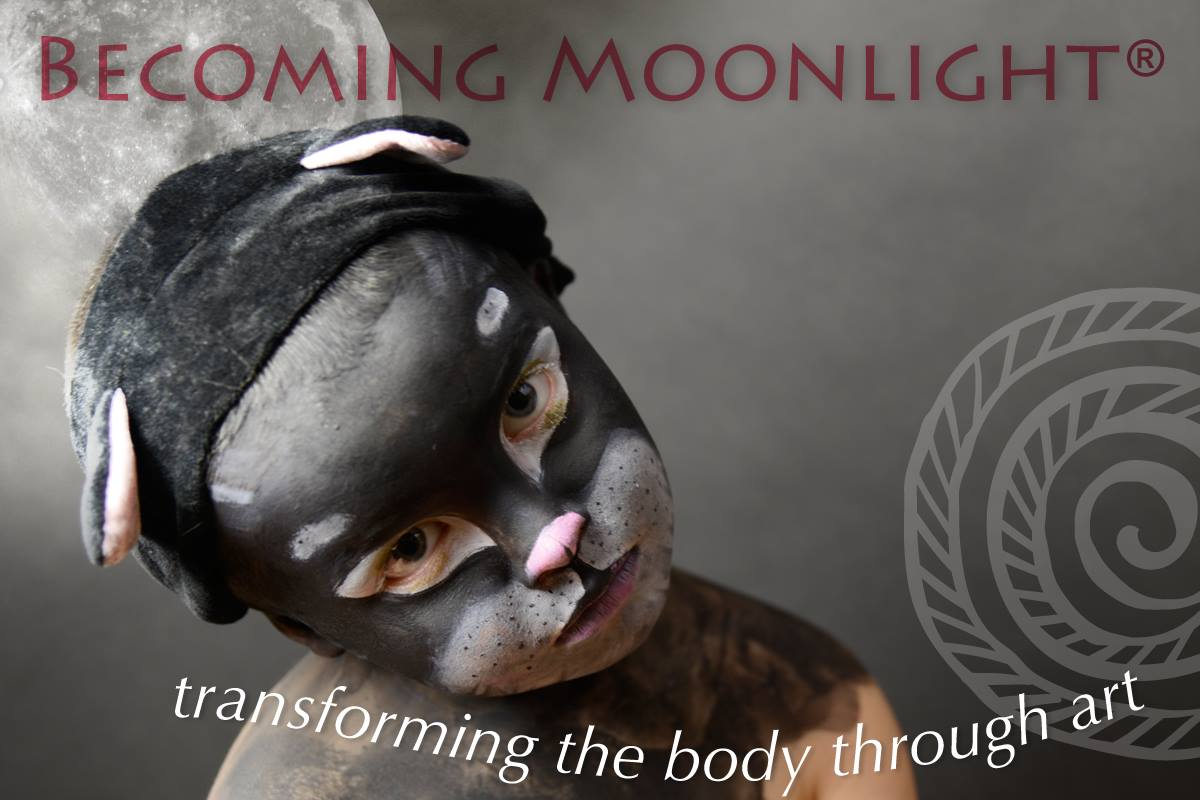
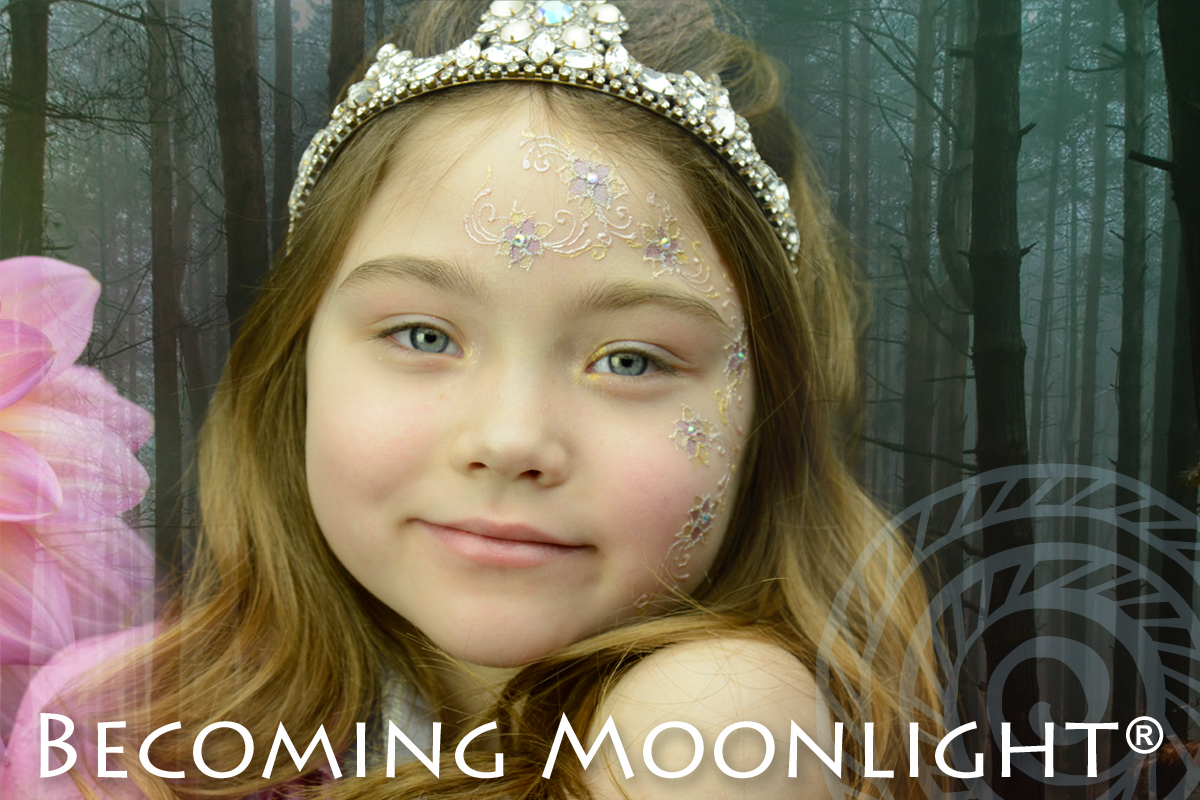
Playing dress-up, Becoming Moonlight® style.
Body art by Maria Moore and Alexander Limbach, respectively. Photography: Roy Jones. Visual Montage: Alex Morgan
Finally, we are like a family to each other. We bring in snacks and groceries to share with one another. We trade clothes. We talk about our families and our lives. We spend time with each other outside of work. For me, one of the hardest parts of moving out of Ohio was leaving my co-workers. I am still a part of the company and communicate with them over the internet, but I miss the day-to-day camaraderie.
Thank you!
Mehandi.com is a company that values solid research and creative collaboration. Our staff come from diverse backgrounds and bring their own unique skills. We love our products and are happy that you do, too. When you order from us, you are supporting a small business, and you are receiving products and knowledge that we are proud of. You are supporting our ongoing research and innovation. You are supporting our families and fur babies. On behalf of everyone at Mehandi.com, thank you for being part of our family!
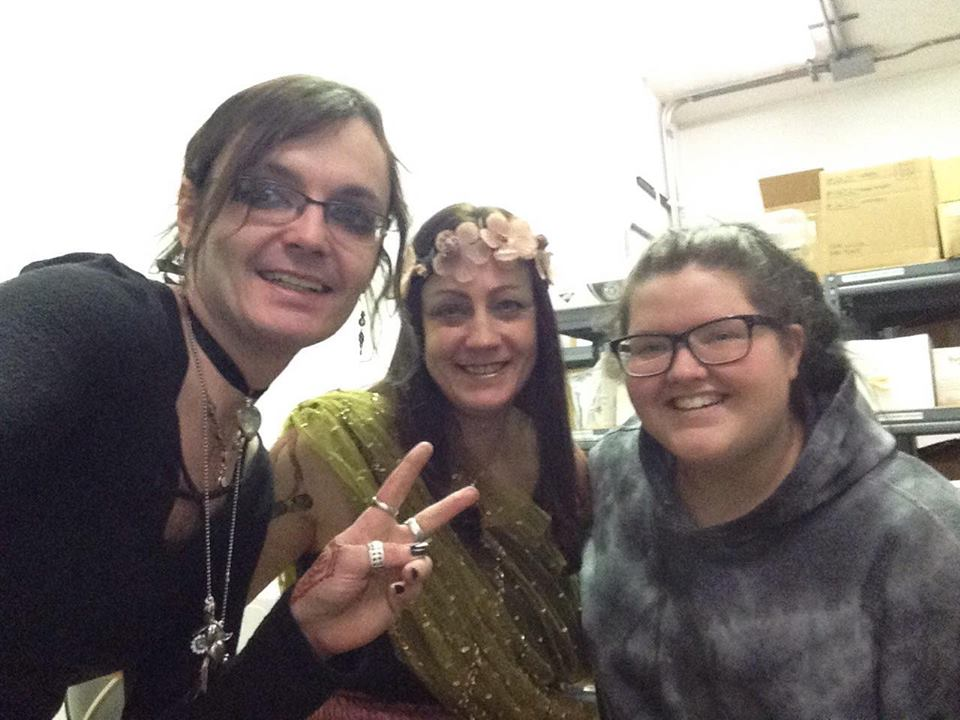
Alex, Michelle, and Maria (Empire, Inventory, and Customer Service, respectively) after a body art and makeup photoshoot. Photo credit: Alexander Limbach
In memory of Carl and Jenny <3.
Author: Rebecca Chou
Updated: Maria Moore November 2022
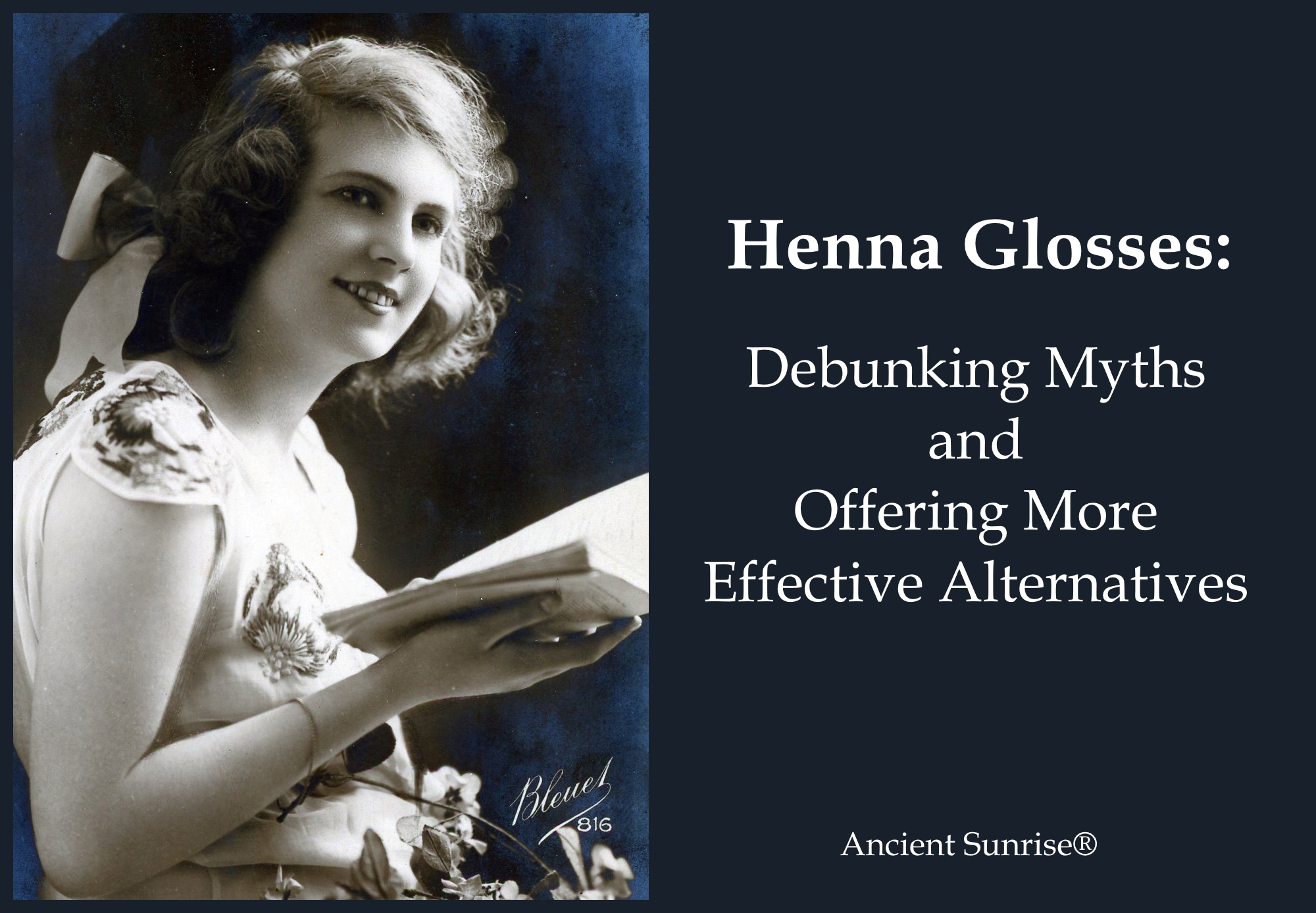
In the henna for hair world, a “gloss” is usually a mixture of prepared henna and/or indigo paste diluted with conditioner, yogurt, aloe gel, coconut milk, or some other medium. The result is supposedly a more subtle color change along with “deep conditioning.” Glosses are extremely popular and attractive, especially to those who are new to henna. They seem to somehow be easier, less intimidating, and user-friendly. The idea of a subtle color change and killing two birds with one stone by mixing henna and conditioner seems wonderful…right?
I’m sorry to burst your bubble. There are better ways to achieve both a subtle color change and conditioning. Glosses are a waste of good henna and your money. Because the diluting medium inhibits dye uptake, color results are temporary, and most of the conditioning benefits of henna are unavailable. While they have their place in rare occasions, more often than not, there is a better alternative to the gloss. This article will explain some of the myths behind glosses, and offer better alternatives which will result in the same subtle color change, but with permanence and all of the benefits we love about henna.
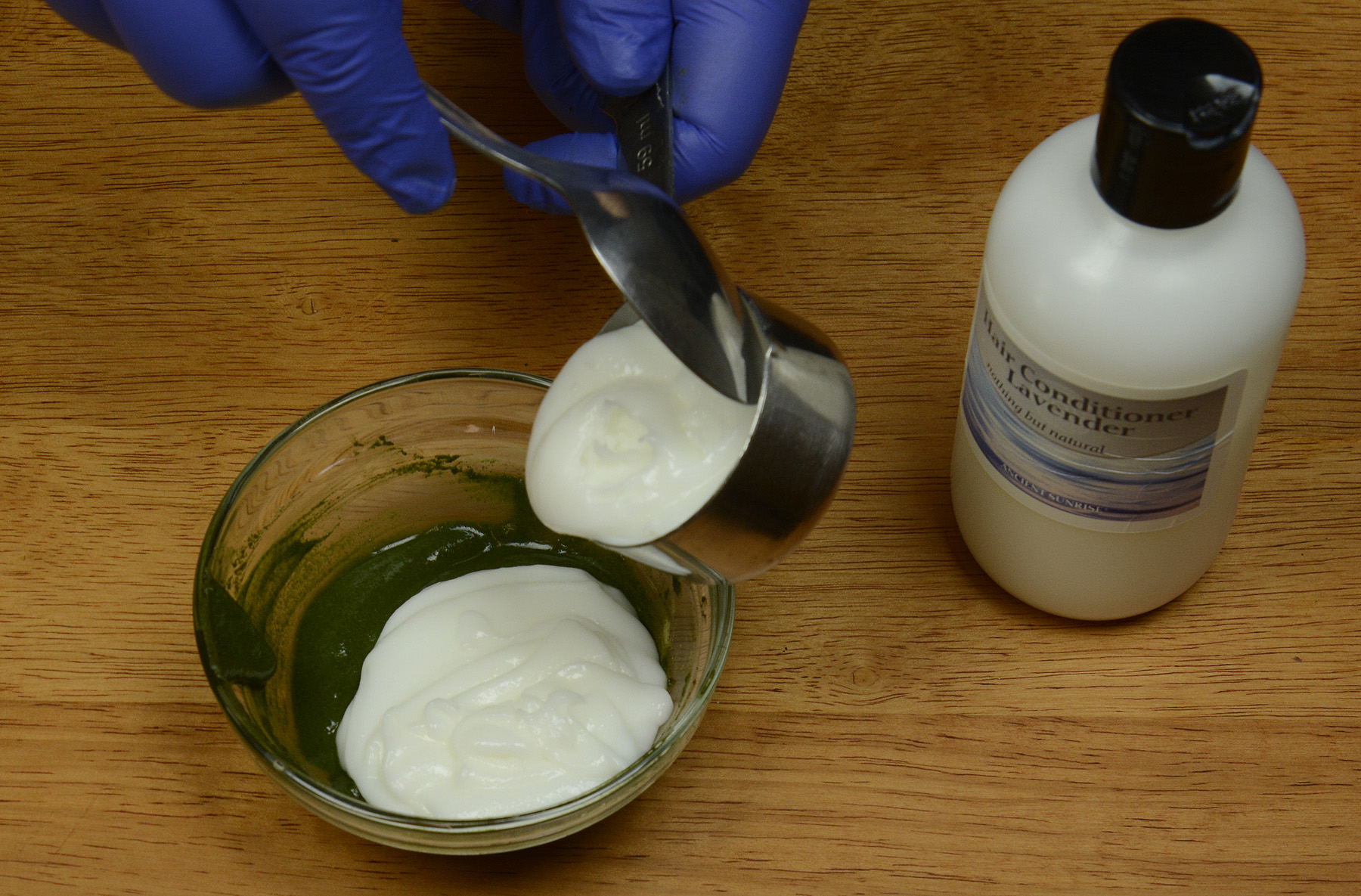
A gloss is a mixture of plant dye paste and conditioner. The result of a gloss is not as saturated, nor as permanent.
For as long as henna has been used to color hair, the mixture has always involved henna and an acidic liquid. Oils, yogurt, milk, and other ingredients were sometimes included in these recipes, and the recipes were passed along. These uses became part of the mythology of “How people used henna back in the day.” Earlier in the history of The Henna Page and Ancient Sunrise®, we tinkered with and recommended methods for using glosses. These were always meant to be a quick, temporary fix, not the go-to method. Over time, the use of the gloss grew, spread through natural beauty blogs and videos, other henna companies, and word of mouth within families and communities. Some companies now even sell oil-based bars containing henna, promising color and conditioning.
If people have been adding all kinds of things to their mix for hundreds of years, it must be the correct way to do it, right? The desire to use natural beauty products sometimes comes with a desire to go back to a mythical time of purity: A time before commercialization brought about harmful chemicals, when humans were more intuitively connected with nature and all things healthy. Looking back on older methods and recipes seems to make sense. Sadly, this mythical time did not exist. People also once painted their faces with lead and brushed their teeth with urine.
Past methods come shrouded in nostalgia, packed with folk remedies and wives’ tales, and lacking good science. We have science now! By systematically studying how these ingredients work at the molecular level, we can now determine the most effective methods, and come to the conclusion that adding certain ingredients into henna mixes renders the mix much less effective. An effective henna mix only requires quality henna powder, an acidic liquid, and an understanding of temperature and time. Oils, fats, silicones, and glycerins block dye molecules from binding to the hair strand. Much of the valuable benefits to henna are doing right down your drain.
Henna is an amazing conditioner. In addition to adding strength and shine to your hair, it re-balances moisture, reinforces the keratin cuticle, and has anti-fungal properties. Make it into the gloss, and you won’t get all of those amazing benefits at their full strength.
There is an ongoing myth that henna is drying or damaging to the hair. This myth has contributed to the use of oils, conditioners, and other “moisturizing” ingredients in a henna mixture. The idea was that the addition of these ingredients would protect the hair from negative effects of henna. Some henna for hair products are made of poor quality henna, full of large plant particles and sand. Compound hennas contain metallic salts, PPD, and other additives that did nasty things to the hair. If you are using finely sifted, 100% pure BAQ henna, the idea of henna being drying or damaging is absolutely untrue.

Most earlier hennas available in the US were compound hennas, containing harmful additives. There are still compound hennas sold today, which claim to be pure. Always go with lab-tested henna!
Some people report their hair feeling dry and unmanageable after using henna. This is because, when the paste is processing on your head, the low pH causes the outer keratin scales of the hair to temporarily lift, allowing the dye to enter more effectively. During the following days, as the dye oxidizes and settles into place, the hair will go back to normal. Rinsing with cool water and/or vinegar can smooth the cuticle down more quickly.
There is nothing wrong with using a conditioning treatment after washing out your henna. Feel free to apply whatever you planned to mix into your henna, separately and after you have hennaed your hair. Many people find that it is not necessary, as henna is an effective enough conditioning treatment on its own.
Many people begin with glosses when they start using henna, and find that they love the results. They continue to use the same method for several years. While they do get some color and conditioning benefit, without learning new and better methods, they never know how much better it could be! It’s like having a California roll for the first time and deciding that you love sushi, but never eating anything other than California rolls following that. (Okay, a bit of a stretched analogy, but I will personally fight you on the ways of proper sushi.)
Try one of the methods I’ll describe later in this article. Henna, indigo, cassia, and fruit acid powders make natural hair coloring amazingly versatile, and you’ll find you can achieve nearly any natural hair color with the right mixture. You will find that skipping the conditioner gives you a much richer color that doesn’t fade, and longer-lasting strength and shine.
You don’t have to have one. At Ancient Sunrise®, we’ve mastered the art and science of formulating mixtures to suit every need. We work one-on-one with our customers to help them achieve their desired color. Very often, our customers simply want to cover their gray hair to match their natural color. If you want just a hint of red, or to darken your color one or two shades, that’s no problem at all. It can be done with the right mix of henna, indigo, and/or cassia.
It is true that many henna for hair products contain henna that is poorly sifted and full of large particles that get tangled in the hair. If you have not yet tried Ancient Sunrise® products, you may be surprised by the difference. Ancient Sunrise® plant dye powders are finely sifted. Ancient Sunrise® Rajasthani Jasmine henna, Ancient Sunrise® Zekhara indigo, and Ancient Sunrise® Zekhara cassia are the finest out of all of them, and great for those who have thick, curly, or textured hair, as well as those with delicate damaged hair.
Indigo powder can be a little gritty, and this can be solved with a little CMC powder, which makes the paste much silkier without inhibiting the dye.
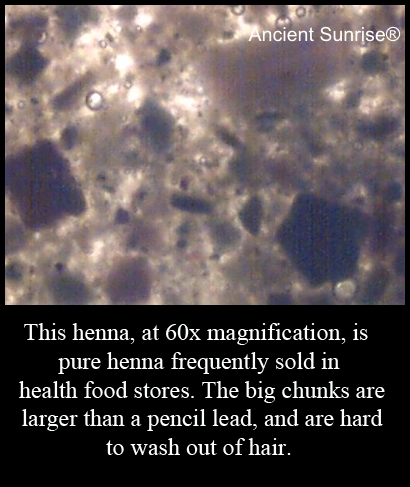
If you are already using Ancient Sunrise® products and are still frustrated with application and washing, contact Customer Service. They have a number of tips and tricks that make the process much easier. For example, some prefer their paste thicker or thinner. Some work from the top of their head down, or vice versa. Some like to enlist a friend or significant other to help. When washing henna out, a “mermaid rinse” works very well. Soak and swish your hair in warm water to loosen out the majority of the paste, then shampoo and condition as normal. Sometimes massaging a handful of conditioner through your hair after the mermaid rinse helps the extra particles slip out. Again, there’s nothing wrong with using conditioners after henna; just don’t mix them in.
Indigo glosses are a mixture of a small amount of indigo paste and a diluting medium, usually conditioner. These are used to subtly darken or tone down hair that is too bright or light after a henna/indigo treatment, or if the indigo has faded from the hair over time. We recommend them occasionally, but they are best used as a temporary fix rather than a true method. The result is not permanent.
If you used indigo in your mix but it did not bind effectively, leaving brassy roots, mix up a small amount of regular, full-strength indigo paste, dab it into the areas that need to be fixed, and rinse it out after a few minutes. If you have just dyed your hair and it looks too bright, wait a few days for the color to oxidize before trying to adjust it. It may settle out on its own.
Indigo glosses can be avoided as you perfect your mix and technique. This may involve increasing the amount of indigo you use in your next mix, and thoroughly cleansing your hair prior to application.

Apply indigo paste, or a henna/indigo mixture to roots that came out too light.
The first and most obvious alternative to the gloss is to simply omit the conditioner, and apply the henna mixture as is. The color results will be more vivid and permanent. Your hair will get the full power of the strengthening and conditioning properties of henna. If you have naturally darker hair, you do not need to worry about your result being too bright or red, as henna is translucent and cannot lighten the hair.
If you have a naturally lighter hair color and worry that henna will make your hair too red, mix it with cassia. A mixture of 1 part henna and 4 parts cassia will give light hair a warm, strawberry blonde glow. Both the henna and cassia will make your hair shiny and strong. You may also choose to play around with acids, or add a small amount of indigo if you don’t want the result to be too bright. This article goes into further detail.
You could try using cassia paste in place of conditioner. Mix cassia powder with distilled water, and combine it with your henna or henna/indigo paste. Cassia that has not been dye-released will impart very little color. It can dilute the strength of your other plant dyes without inhibiting uptake the way conditioner might.
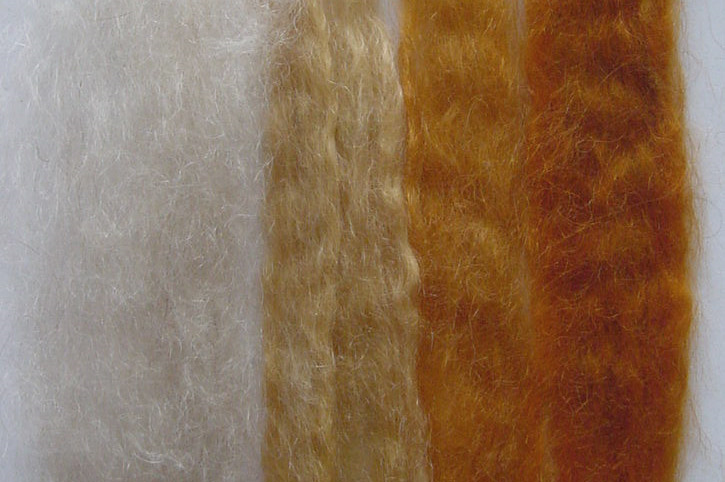
Mohair dyed with cassia and henna in different proportions. The sample to the left is the original color.
If you are new to henna and are attracted to glosses because you are worried about having a permanent result you don’t like, instead of relying on the temporary nature of a gloss, strand-test a few different mixtures on hair that you’ve collected from your hairbrush or a trim, and use those to settle on a color, rather than using your head as a guinea pig.
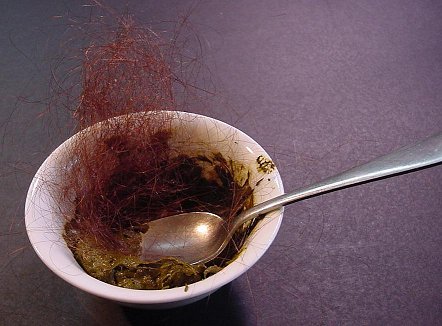
Test some hair collected from your hair brush with a small amount of paste to determine the color result.
If you are using glosses because you want your color change to be temporary, then sure, a gloss may be the way to go. Henna is permanent when used properly, and can only be removed from the hair using lightening treatments. You may want to try mixing up some zizyphus paste to use in place of conditioner in your gloss. Ancient Sunrise® Zizyphus spina christi powder is a natural cleanser and conditioner. Its natural plant waxes may prevent the henna from binding as successfully.
Glosses are overused. They gained popularity through the spread of some less-than-accurate information. More often than not, a full-strength mix of henna, indigo, and/or cassia will give you the same, or better results. It may require some recipe or technique adjustments, but we believe that you will be much happier with the color and condition of your hair after ditching glosses. You will not need to re-apply as frequently, saving money and time. If you need assistance, contact Ancient Sunrise® Customer Service via phone, email, or online chat.
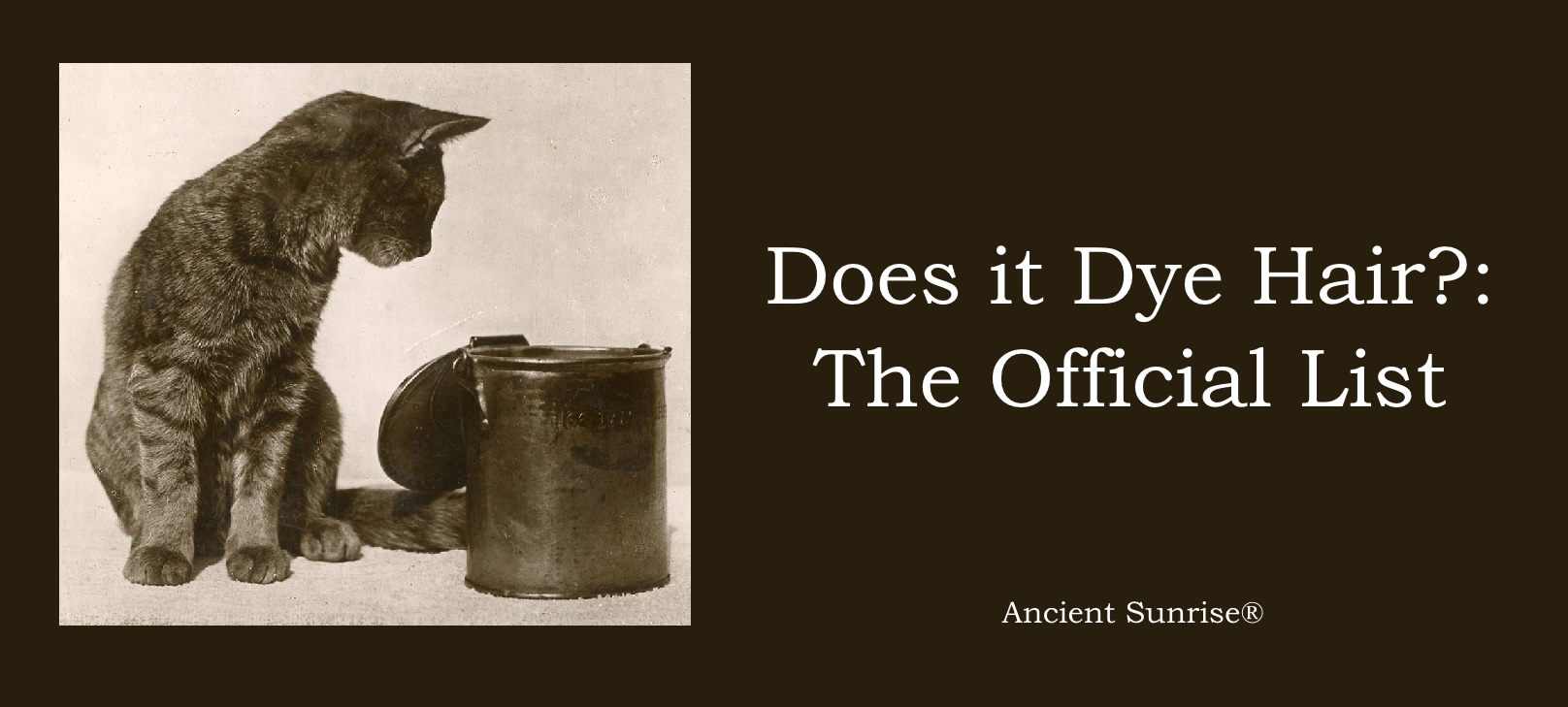
People have been using plants and other materials to change the color of their hair long before commercial hair dyes were invented. The resurgence in natural and DIY beauty has led to a long and strange list of ingredients being mixed up and put on the hair. Many of these are food items. Others are borrowed from natural fabric dyeing. However, just because something is natural and has a color does not mean that it will 1) bind permanently to the hair strand, and/or 2) be safe to use on the hair.
Many plants which will dye fabric require simmering and/or being set with a mordant. Because one should not do either with the hair, it will not work the same way. Most foods are, well, best used as foods. Eat them, and you get nutrients and a happy tummy. Put them on your head, and you get a lot of food rinsed down the drain for very little effect.
There are very, very few dyes that are capable of binding to the hair in a permanent manner. Out of these, there are fewer which are safe (Hint: if it is effective and safe, we probably sell it at Mehandi.com). At a molecular level, a dye needs a small enough molecule or a chemical reaction to break past the keratin layers on the surface of the hair strand, and then oxidize into a larger molecule that cannot easily escape back out of the hair, binding it there permanently. This is what oxidative (store-bought) dyes do.
Dyes like henna and cassia bind to the hair via a Michael addition, facilitated by the low pH environment of the paste. Despite having beautiful, vivid colors, most plants cannot dye the hair because the molecule is too large. Without simmering for long periods of time or the use of a mordant to chemically bind the dye, the color simply sits atop the hair and will wash right out.
Below is a list, in alphabetical order, of the many things people attempt to use, either mixed into a henna treatment or on its own. Each item will be examined for the following questions: 1) Does it affect hair color? 2) Is the color change permanent? 3) Is it safe? Additionally, most will include explanations for how the ingredient came to exist in hair recipes if it is not safe or effective.
Amla does not contain a dye. When used to dye-release henna, it affects the resulting color of the henna by muting brighter tones. It assists a successful indigo bind by temporarily loosening the hydrogen bonds in the hair, allowing more dye to enter. Real amla is safe. If an amla product claims to change the color of the hair, it may contain other ingredients, and may not be safe.
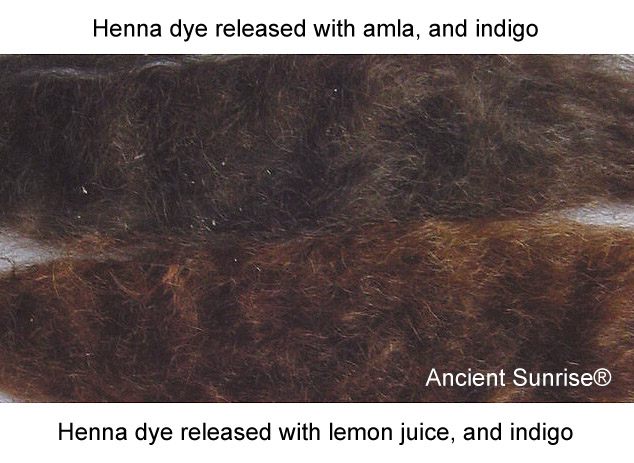
Beets will stain your hands, change the color of your urine, and can dye fabric when simmered and used with a mordant. Because you do not want to simmer and use mordants on your hair, you cannot achieve a permanent stain using beets. It is safe but will do nothing for your hair.
Many natural hair blogs claim that strong black tea will darken your hair. If it does, the result will be very subtle, and very temporary. Some people use black tea as their acidic liquid for henna, but it is generally not quite acidic enough for a good dye release. A strong brew of black tea may cause caffeine jitters when absorbed through the scalp. Relatively safe; not effective for hair coloring.
On its own, blueberries or blueberry juice will not create a noticeable change in your hair color. Added to henna as a dye-releasing liquid, the anthocyanins in blueberry juice will add a subtle ash tone to the color to cool it. This effect may fade over time. It is safe, but subtle and not permanent. Ancient Sunrise® Nightfall Rose fruit acid powder is made from powdered purple aronia fruit, which is like a hardcore version of the blueberry.
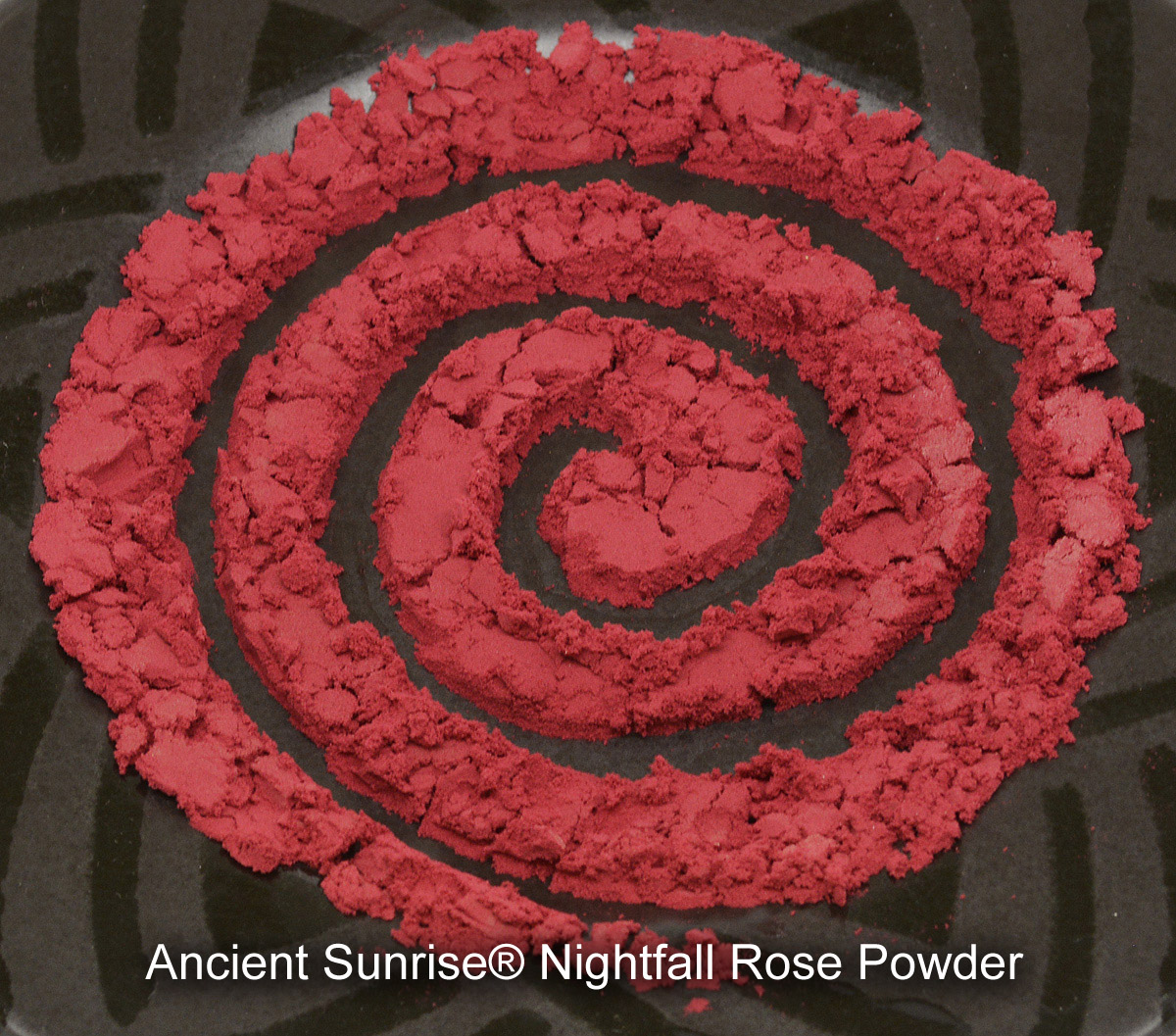
Buxus is mixed with henna in the same way that indigo is, to create soft brunette tones. It is safe. Here’s the problem: Buxus was produced in Yemen, which is under civil conflict. There are few if any producers of buxus left, and Yemen is not exporting goods to the US at this time. If you find anyone claiming to sell buxus, it is most likely a mixture of henna and indigo or some other type of counterfeit.
Calendula is a bright yellow flower. It is used as a natural fabric and food dye. It is sometimes used to give a golden tone to cheese and butter. Calendula will show up in an internet search for natural ways to dye your hair. Like so many other items on this list, calendula’s dye will not break into and bind to the keratin cuticle of your hair without the use of heat and mordants.
Carrot juice is delicious. Carrots are a good way to make friends with rabbits or horses. Despite their bright orange color, soaking your hair in carrot juice will not do much. Safe, but better eaten. Any color result that may occur will wash out.
Hooray! The first effective contestant on the list. Cassia Auriculata will dye light hair a golden wheat color. It provides similar benefits as henna. Not quite as strong or permanent as henna, cassia may need to be applied more often, or mixed with a small amount of henna for a more effective bind. Cassia is great for diluting henna or henna/indigo mixes to great vibrant fiery reds, or lighter browns. On dark hair, cassia will not cause a color change but is great for conditioning. Cassia is very safe.
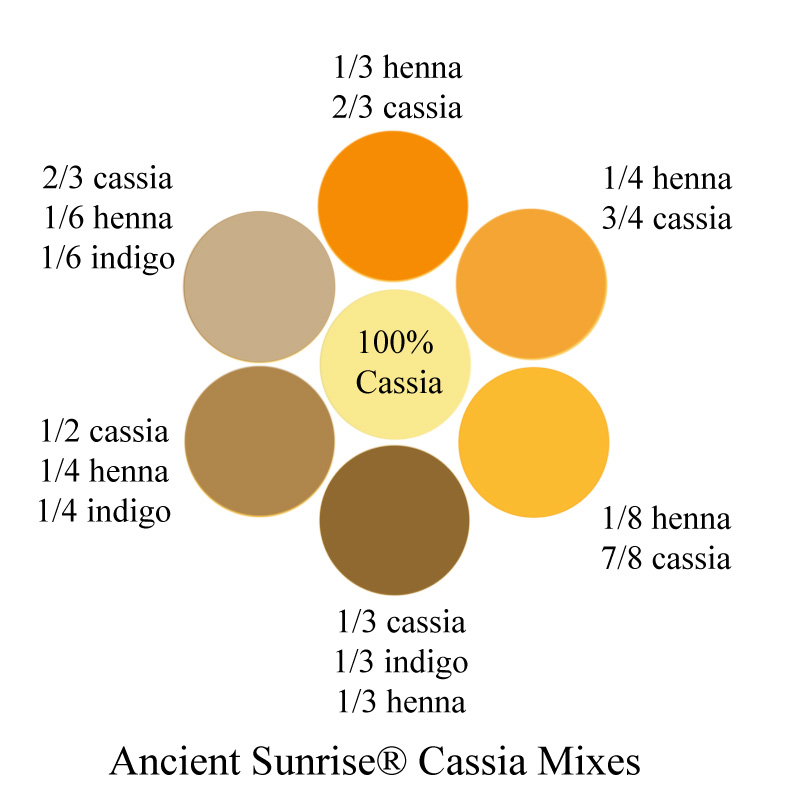
Chamomile shows up in natural beauty sites very often because it is supposed to naturally lighten hair. The instructions usually involve soaking hair in chamomile tea or spritzing the hair with tea in a spray bottle. Like lemon, some use it in their hair prior to going out into the sun. Chamomile seems to deliver very subtle, very slow results that appear if one’s hair is already blonde or light brown. If your hair is dark, no luck. If your hair is dyed with henna, chamomile will not remove the henna. With hair that is already light brown or blonde, it would take weeks of daily hair-soaking and dozens of tea bags to achieve a noticeable difference if any at all. Chamomile is not a strong enough acid to use for dye-releasing henna. It is safe, but drinking chamomile tea may make you sleepy.
Many people long to have hair the same color as black cherries. That deep, purple-red is gorgeous, and sadly, only achievable with chemical dyes. Cherry juice might be a good contestant for dye-release liquid, but because of its antioxidant and anthocyanin content, not because of its color. Cherries are safe, as long as you are not allergic, and remember to spit out the pits.
Cinnamon is another common ingredient in natural beauty recipes for lightening hair. It smells wonderful, but cinnamon is irritating to the skin. I once tried the cinnamon-and-honey hair mask out of curiosity, and it felt like I rubbed tiger balm all over my scalp. Like lemon, honey, and chamomile, if there is any effect at all, it would show up on hair that is already light, require several treatments, and be very subtle. Not entirely safe, and not very effective. Will do nothing to the color result of a henna mix. If you want to make your henna mix smell nice, try ginger or cardamom powder instead.
This is one of the most common items people ask about. Some henna sites still recommend mixing henna with strongly brewed black coffee. Coffee seems to temporarily darken the hair, but caffeine is transdermal and will cause jitters and headaches if you leave it on your scalp for several hours. You will also have to put up with the smell. Imagine breathing through a used coffee filter for three hours. A coffee “rinse” would do nothing. Do not put coffee in your mix. If you want to darken your henna, add a little indigo.
Bright yellow flower. Fun for making wishes. Used in salads. See Calendula above.
Pure, BAQ henna is safe, effective, and permanent. But if you are reading this blog, you might know that by now. Feel free to read the other articles to learn all about how to use it. Henna allergies are extremely rare. Henna’s dye molecule binds to keratin and will not fade. Because henna is not well regulated, all henna is not equal. Make sure you know the difference between true henna and compound henna, which is unsafe and contains a number of additives.
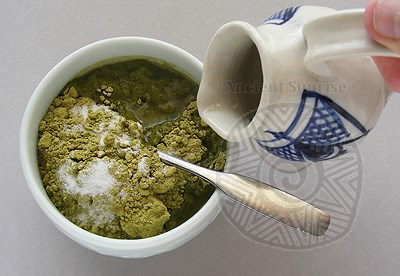
Honey produces small amounts of peroxide, which can bring out some highlights to hair that is already light. The effect is minimal. It will not do anything to dark hair. Do not add it to a henna mix; it will inhibit dye uptake. It is safe unless you are an infant, or allergic to honey. Honey is great with some peanut butter on toast. It is also nice in tea. In your hair, it is a sticky mess that won’t do much.
Used in conjunction with henna, indigo creates permanent shades of brunette. On its own, it may dye lighter hair a gray-blue color, which may fade. Henna helps indigo bind permanently. It is safe. Some with mold allergies notice a reaction to indigo. Patch test beforehand if concerned, and avoid inhaling powder particles. Read more about indigo here.
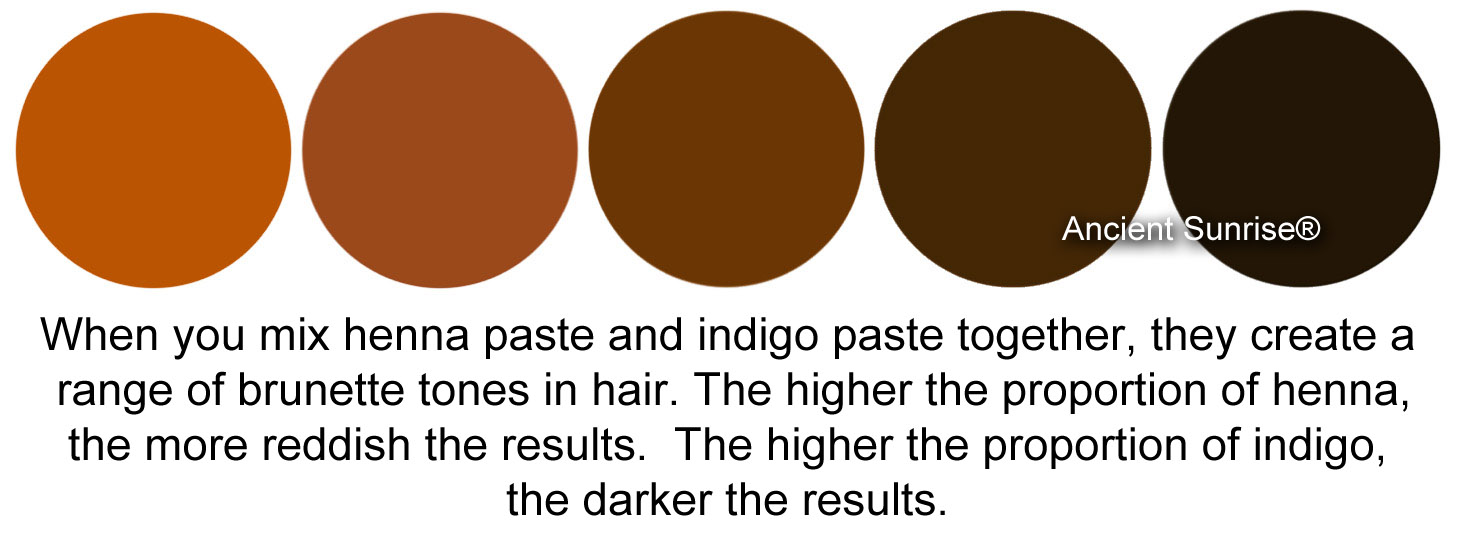
Jagua is derived from the fruit, Genipa americana which grows in South America. Its juice has been used in body art to create deep blue stains on the skin. Jagua is extremely expensive. The amount of jagua juice needed to mix with 100g of henna powder would be over a hundred dollars. Not worth it. Jagua is also known to cause allergies in those who are allergic to certain fruits. Some distributors may sell products containing PPD claiming it is pure jagua. Verdict: Not for hair, expensive, and proceed with caution.
Dyeing hair with powdered drink mixes is popular among young people because it is cheap, temporary, and can result in unnatural colors. The high concentration of food dyes can cause a temporary stain on lighter hair. It is relatively safe, but not permanent, and not necessarily “natural.” It will probably stain your clothes and pillowcase as it fades off. Adding it to henna would probably not do anything, as the lawsone would greatly overpower any food dye.
Lemon juice has been used to add highlights to blond hair. It works similarly to peroxide. You will not see much change in darker hair. It will not lighten hair that has been dyed with henna. When used as an acid in a henna mix, the low pH will actually cause the resulting stain to oxidize greatly over time, causing a darker color. Those who are sensitive to citrus may notice an itchy, bumpy, or red scalp when using henna mixed with lemon juice. It can also cause UV sensitivity. When used with henna, it is smart to dilute lemon juice with 3-4 parts distilled water.
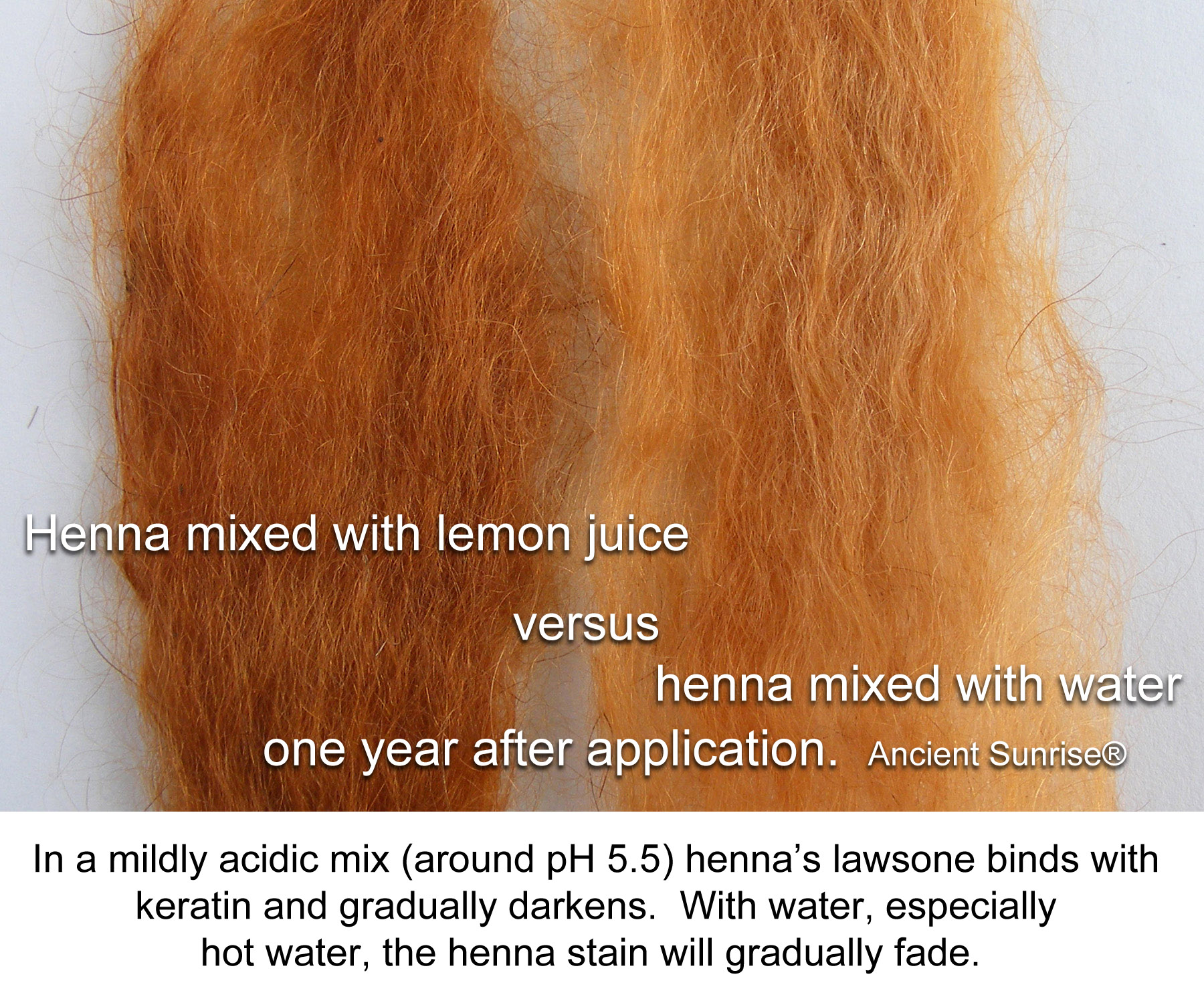
This is another plant that is popular in natural beauty blogs. Hibiscus is a beautiful red flower with a sweet, tart flavor. The flowers are dried and sold whole and in powder form. According to those who recommend using it, hibiscus supposedly brings red hues to the hair. If effective, the result would be very temporary. Hibiscus is high in anthocyanins, so if there is any effect of it being mixed with henna, it would act more like Ancient Sunrise® Nightfall Rose fruit acid powder, or blueberry juice, cooling the henna color rather than adding red tones. Hibiscus makes for a delicious cold summer drink. Save it for that, instead.
Some cultures have mixed henna in iron containers, and this recommendation has come through to blogs and natural sites today. Some sites recommend adding a few rusty nails (or any rusty iron item) into the henna if you do not have an iron pot. A low-pH liquid would react with the iron to create iron oxide, which may impart a dark color to the hair temporarily. You do not want minerals in your hair. Not only does mineral buildup inhibit dye uptake, but can cause the hair to become stiff and dry. This is why we recommend clarifying the hair before applying henna and using distilled water.
Note: This is not to say that henna and metal should never mix. Henna can be mixed in stainless steel bowls, or with any run-of-the-mill spoon just fine.
Nettle has been recommended on some natural beauty sites claiming it will darken hair and stimulate growth. It can dye fabrics but requires simmering and mordants to do so. There will be little to no effect on hair. There are no studies that show significant effects on hair growth. While nettle can be eaten, or used for tea, harvesting nettle from the great outdoors can result in some nasty stings.
This is another one pulled from fabric dyeing. Onion skins can dye fabrics a lovely yellow color. It will not work on hair. Some claim that rinsing hair in water that has been boiled with onion or onion skin will promote hair growth. This claim has not been proven. Do yourself and others a favor, and do not put onions in your henna, or in your hair at all. You will end up smelling like onions for no reason.
Pomegranates have an absolutely beautiful color, and anyone who has opened one will know that the juice can stain your skin, clothes, and cutting board. It will not stay in your hair. There’s nothing wrong with using it as your dye-release liquid, other than expense. It is high in anthocyanins, so it would most likely work similarly to blueberry juice.
See: Blueberry, Cherry, and Pomegranate. Safe, and decent for a dye-release liquid; will not dye hair.
You may have done the experiment in science class where you use cabbage juice as a pH indicator. If not, it’s pretty cool. The purple liquid turns shades of pink when mixed with an acid, and blue to green when mixed with a base. Fabric dyers can use this to their advantage to create a variety of shades. I feel like a broken record by now but guess what. Works with simmering and a mordant; won’t work on hair.
Rhubarb supposedly adds a golden tone to light hair. It is recommended on natural beauty sites and is sometimes included in “herbal” or “natural” hair dye mixes. Despite its pretty, red stalks, rhubarb will not add red tones to the hair. It contains chrysophanic acid, the same molecule responsible for cassia’s golden results. However, rhubarb root creates a very vivid, unnatural yellow that isn’t generally desired as a hair color. In addition, the dye does not bind well and fades over time. Better saved for fabric dyeing and pies.
Rosemary oil has long been recommended and used for hair growth and darkening hair. After scouring research databases, I found one clinical study which showed the effectiveness of rosemary oil against androgenetic alopecia, and none on hair darkening. Because only the abstract was available I could not make a determination on the soundness of the study. The claimed hair-growth effect is due to rosemary’s rubefacient quality. Rubefacients are by their nature, irritants. They stimulate circulation (redness) in the skin by dilating blood vessels. Do not put essential oils in henna. They dull the resulting color and can cause headaches.
Holy expense. Not only will it fail to alter your hair color, but a gram of real saffron can cost up to $25. It is the most expensive spice in the world, and counterfeit/adulterated saffron is common. Saffron rice is delicious. If you get your hands on some real saffron, make rice. Safe, expensive, and pointless for hair.
Similar claims as Rosemary. Just like Rosemary, there is no definitive proof of sage’s ability to dye hair. Pretty safe. Good for clearing your home of ghouls and ghosties, or bad smells. Not effective for coloring hair.
NOT SAFE. Para-phenylenediamine is the active ingredient in most commercial hair dyes and is highly sensitizing. Yes, it effectively colors hair. It is also known to cause serious allergic reactions. Sensitivity to PPD is increasing due to the popularity of “black henna” tattoos, which use a concentrated form of dye. As a coal tar derivative, it is not natural. Read more about it here, here, here, and here.
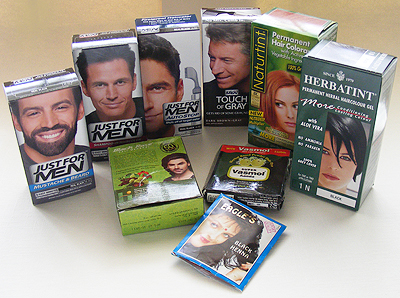
Most commercial hair dyes contain PPD. Even products labeled “natural” or claiming to be henna can have PPD.
If you’ve ever spilled pasta sauce or ketchup on your clothes, you were probably quite happy to find that the stain did not stay permanently. Soaking your hair in tomato juice is not an effective way to dye your hair, and like many other items on this list, any color result obtained will wash out. Tomatoes are acidic, so I can’t think of anything wrong with using tomato juice as a dye-release liquid, other than the fact that it would smell very strange. Better idea: enjoy a Bloody Mary while the henna is in your hair.
Turmeric gives curry dishes their bright yellow color. It is used in fabric dyeing. When mixed with an alkaline solution, turmeric’s ochre yellow color turns vivid red. When turmeric paste is rubbed onto the skin, it will leave a yellow stain. Turmeric may temporarily stain light hair yellow but will wash out quickly. Be prepared to turn your tub and towels yellow. Safe; beautiful color; will not dye hair.
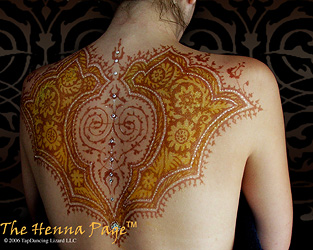
Turmeric was used to stain the skin yellow in this body art piece. It will fade away after a good scrub.
Black walnut powder has been sold on its own and in pre-mixed henna powders. It leads to darker results. Black walnut will dye hair but has a high risk of allergic reaction. Indigo will work just as well, if not better. Somewhat effective, but not as safe.
Mehandi.com no longer carries indigo for body art due to it being hard to resource.
Woad is one of the most ancient dyes, used to dye fabrics “Celtic blue.” It is speculated that the Celts also used it on their skin, as seen in the movie Braveheart. The process is extremely smelly, like rotten cabbages. The dye molecule, indigo, in woad is the same as it is in the indigo (indigofera tinctoria) plant. Just use indigo plant powder. It is easier to get your hands on and doesn’t have the stink. If you want to paint yourself blue.
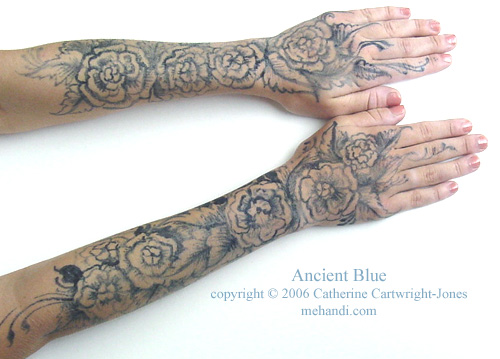
Ancient Blue® is an indigo product that mimics the use of woad on the skin, without the cabbage stink.
All in all, it is best to keep a henna mix to its bare essentials and to keep food for eating purposes. Many foods do have nutrients that are beneficial for hair and skin, but in order to take advantage of them, you need to process them through your digestive system. Additionally, if you don’t already have these items laying around, going out and finding them only complicates and adds expense to your henna method, for no real pay-off.
Please don’t hesitate to contact Ancient Sunrise® Customer Service if you have any additional questions. If there is an item you’d like to see added to this list, please comment below.
Author: Rebecca Chou 2/23/18
Edited: Maria Moore 11/16/22
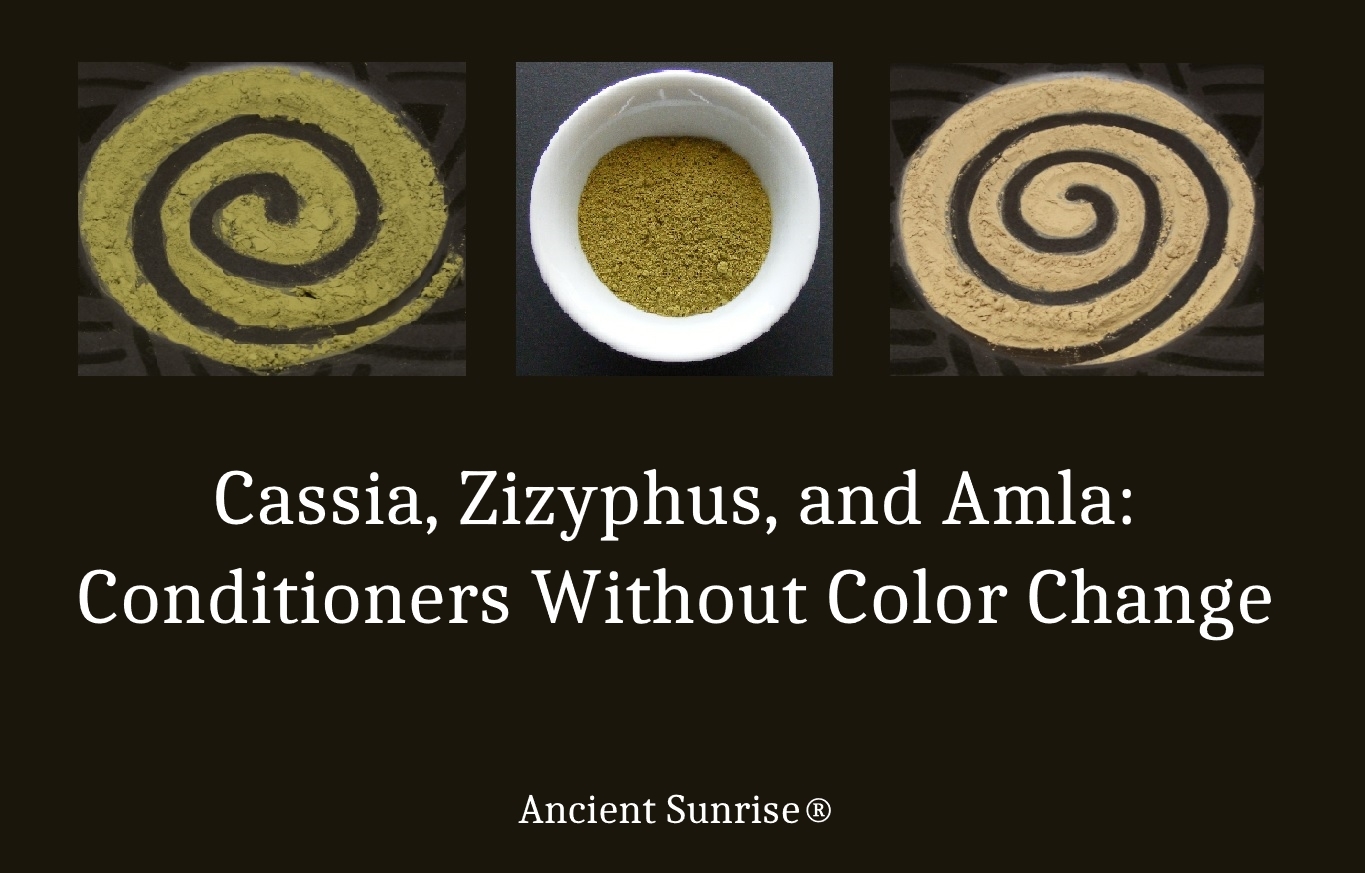
Henna provides some great conditioning benefits, but these benefits go hand-in-hand with color change. The lawsone molecule binds permanently to the keratin in your hair, providing strength and shine while dyeing the hair. That’s great for those who wish to dye and condition their hair simultaneously. But what if you’ve already achieved your desired color, and want to regularly condition without seeing the color darken? Continued application of henna can cause the hair to become a darker and darker color. Or, what if you have light or gray hair which you wish to keep the way it is?
Ancient Sunrise® Cassia provides similar conditioning benefits as henna with little to minimal color change on darker hair colors. Ancient Sunrise® Zizyphus Spina Christi cleanses and conditions the hair with no color change at all. Repeated applications of henna can also cause curl pattern loosening for some. Some find that using Ancient Sunrise® Amla alone in the hair helps to bring back volume, while others find that cassia helps to restore their curls. This article will explain how to use Cassia, Zizyphus, and Amla powders as hair treatments that provide conditioning without color change.
The Plant Powders
Cassia Auriculata, Cassia Obovata, Zizyphus Spina Christi, and Amla (emblica officinalis) powders all work in different ways. Cassia works most similarly to henna. Its dye molecule, chrysophanol, binds to the hair much like henna’s lawsone molecule does. Cassia makes the hair shiny and strong, and for some, can restore the hair’s natural curl pattern. Cassia’s conditioning effects can last up to a month or longer. Zizyphus acts as a two-in-one cleanser/conditioner that adds a thin plant wax coating to the hair, protecting it from environmental effects, and giving the hair shine and strength. Zizyphus can be used weekly. Amla is not a conditioner as much as a hair treatment most useful for those who wish to give their hair extra body and bounce. Each of these powders has a unique process. Continue reading to learn the best ways to use them.
Cassia Obovata and Cassia Auriculata Powder
For Benefits Similar to Henna, and for Curls
Ancient Sunrise® Cassia is great if you love the way that henna makes your hair strong and shiny, but want to avoid repeating full-head henna treatments which may darken your color. Cassia can be used in one of two ways:
For a quick conditioning treatment, mix Ancient Sunrise® Cassia powder with distilled water and apply immediately. Cover and leave it on the hair as long as desired (one hour is good). This is a good method for those who have light or gray hair and do not want a noticeable color change. This method will condition hair with little to no color change, but will not yield effects that are as strong or permanent as the method below.
For a more effective, and longer-lasting conditioning treatment, mix cassia with a mildly acidic liquid or an Ancient Sunrise® fruit acid powder and distilled water, and allow it to dye-release at room temperature for 8-12 hours just as you would with henna. Apply, cover, and leave in the hair for one hour to several hours. Those with darker hair will not see any color change. Lighter or gray hair will be dyed a golden tone.
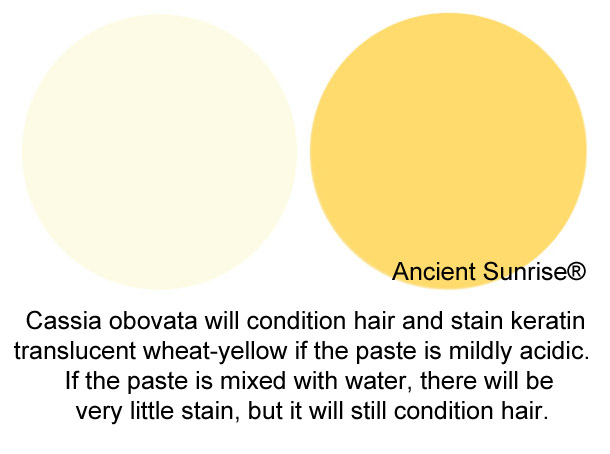
Ancient Sunrise® cassia, like Ancient Sunrise® henna, can be applied to either damp or dry hair. Ancient Sunrise® Clarity Cassia has a fine sift and is great for those with thin, delicate, and damaged hair.
Important: Cassia’s dye molecule reacts poorly with minerals. The golden tone can become muddy and brown if you have mineral build-up in your hair. It is best to do a Rainwash treatment ahead of time for the best results.
Cassia can be used as a conditioner once a month, or more frequently if desired. Its effects are not as permanent as henna; it is fine to apply a new treatment whenever you feel your hair needs it.
Cassia Auriculata has a weaker dye molecule than Cassia Obovata, but it is a great replacement. You can learn more about Cassia Auriculata here: http://www.hennaforhair.com/faq/Clarity_cassia-auriculata.pdf.
Zizyphus Spina Christi Powder
For Clean, Shiny Hair Protected Against the Elements
Zizyphus Spina Christi does not contain a dye molecule. Its natural saponins and plant wax clean the hair and protect it with a thin, flexible layer. Ancient Sunrise® Zizyphus is perfect for those who want absolutely no color change. Use zizyphus before and/or during a trip to the beach or the great outdoors. It protects the hair from salt water, wind, and dirt. Some notice that they can wash their hair less frequently when using zizyphus (Note: Please wash your hair once it feels greasy, or smells bad.) It is quicker and easier to use than cassia, but its effects are washed away after a number of shampoos.
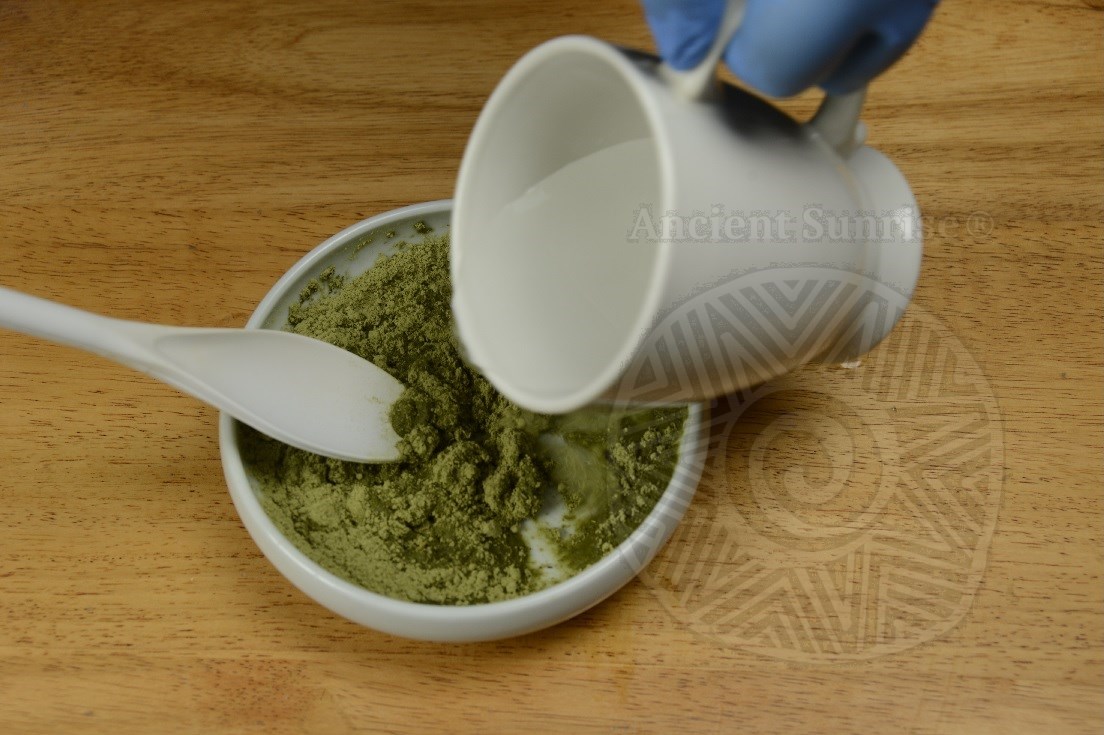
To use Zizyphus Spina Christi powder, mix a heaping tablespoon of powder with distilled water until it becomes a fluffy paste. Bring this paste to the shower with you, and set it nearby, but away from the direct stream of water. Wet your hair, and apply the paste from scalp to ends, massaging your scalp. You may need to work in sections. Leave the paste in your hair for several minutes, then rinse. If you are having trouble rinsing the paste completely, use a small amount of conditioner or a vinegar rinse to give your hair more slip. Dry and style as usual. You can use zizyphus once or twice a week. More often may cause a build-up of the coating, causing your hair to feel stiff or waxy.
As zizyphus creates a hydrophobic barrier over the hair, make sure to wash your hair with a normal detergent shampoo prior to applying a plant powder dye to ensure effective dye uptake.
Important: If you are sensitive to latex, conduct a patch test before using zizyphus. Those with latex allergies often experience a cross-reaction when using zizyphus.
Read more about Zizyphus Spina Christi here.
Amla (Emblica Officinalis) Powder
For Fluffy, Voluminous Hair
As noted earlier, amla is not necessarily a conditioner in the same sense as cassia and zizyphus are. It is acidic, and therefore may be drying for some. When used in a plant dye mix, amla can prevent the curl loss that sometimes occurs with henna. On its own, amla can give the hair more volume and bounce. It does this by temporarily loosening the hydrogen bonds in keratin, allowing the hair to be reshaped.
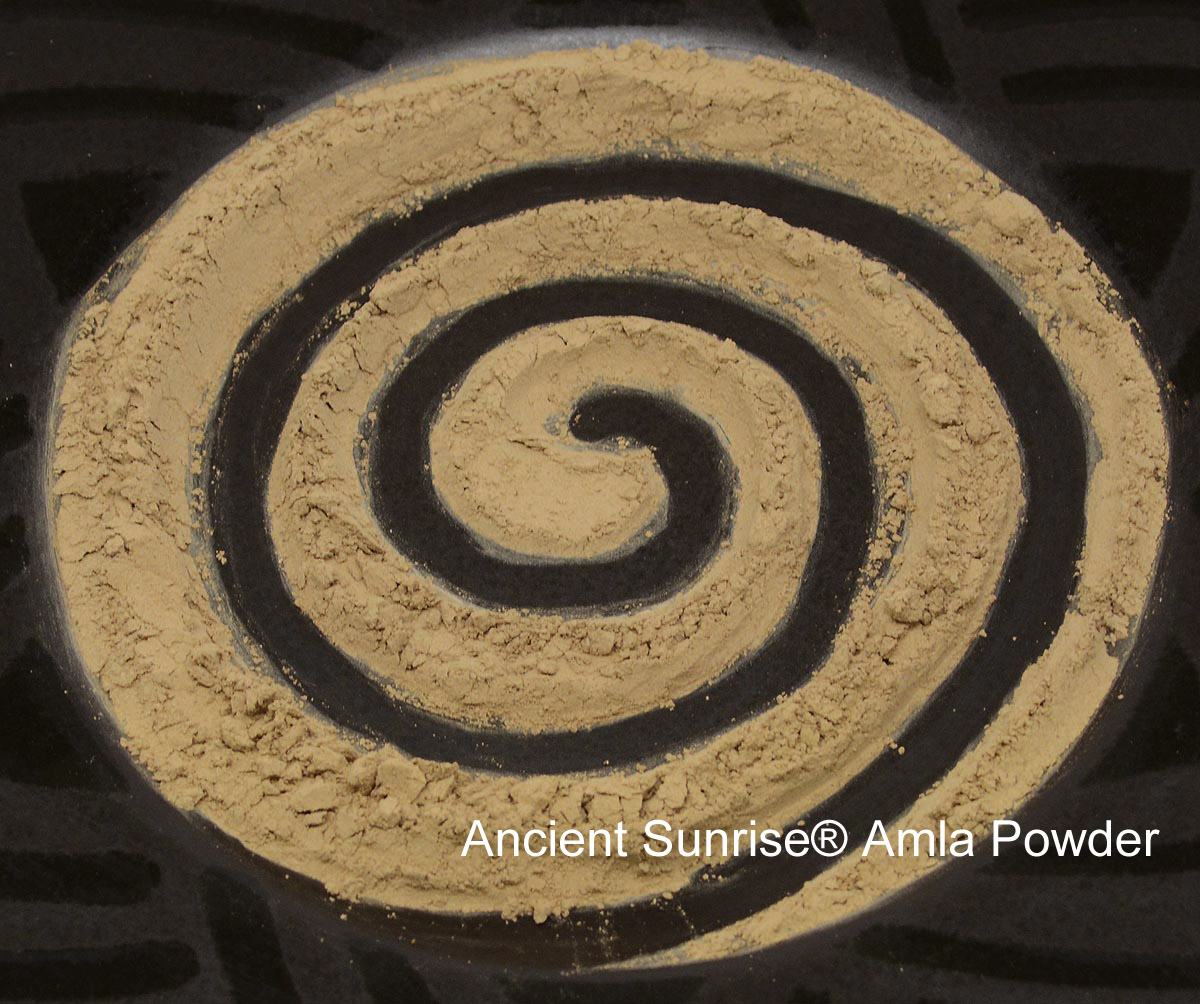
Mix Ancient Sunrise® Amla powder with distilled water into a thin paste. It does not have to be as thick as henna. Apply from roots to ends, cover, and leave in for 10 minutes. Rinse, and set towel-dry hair in a braid, curlers, or another heatless curl method. When the hair is dry, it will be fuller and fluffier.
Ancient Sunrise® Amla can be used as an acid to dye-release cassia. Mix 25g amla for every 100g cassia, and add distilled water. Follow the instructions above for applying and processing cassia.
Read more about various uses for Ancient Sunrise® Amla Powder here.
Final Notes
Repeated applications of any of these methods will show more improvement in hair quality over time. Conditioning protects the hair against damage, and balances moisture retention, allowing the hair to stay stronger longer. For best results, use Cassia monthly (or more often if desired), Zizyphus weekly, and Amla whenever you wish to add some temporary oomph to your hair. These methods can all be used on hair that has been treated with plant dyes, as well as hair that has not.
If you have any additional questions about using these products to add strength, shine, and body to your hair, feel free to contact a Customer Service Representative via phone, email, or online chat.
Author: Rebecca Chou
Updated by Maria Moore 11/16/22
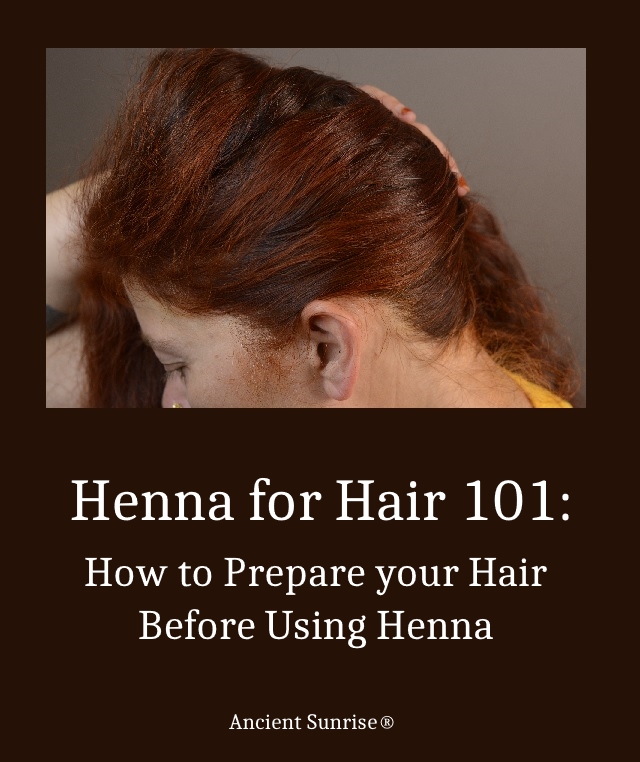
People frequently ask what they should or should not do to their hair before applying henna. Does hair need to be clean, or left unwashed? Can it have conditioner on it? Should it be wet or dry? As henna works differently from conventional hair dyes and treatments, these questions are valid. This article will explain the best ways to prepare your hair for your henna treatment to obtain the best results.
First of all, hair should definitely be clean. But “clean” means several things. For henna and plant dye mixtures, it means, 1) free of dirt; 2) free of oils, both natural and added; and 3) free of mineral build-up. Dirt, oil, and mineral build-up all create barriers that prevent the dye from binding properly to the hair strand, for the best coverage and permanence, it will be important to start with squeaky-clean hair. Second, it is important to avoid adding oils or conditioning products to the hair prior to using henna, as they can inhibit dye uptake. Finally, hair can be either damp or dry when applying henna, whatever makes the hair easier to separate into sections for application. Continue reading to learn more about how to prep your hair and why.
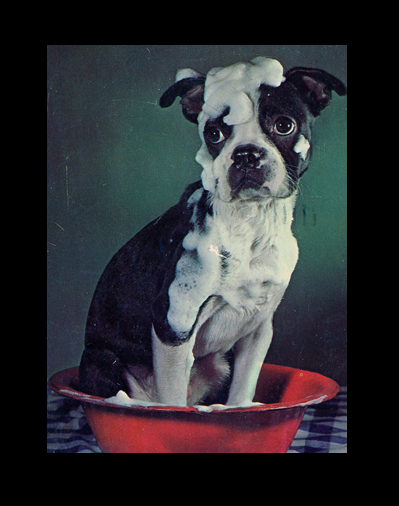
When left unwashed, hair collects dirt and pollutants from the environment, as well as dead skin and materials excreted through the sweat glands. Combined with the body’s natural oils and heat, the hair becomes a perfect playground for bacteria and microbes.
While henna has anti-microbial properties, it does not necessarily make for the best hair cleanser. Henna is best known for its coloring and strengthening properties, which come from the dye molecule, lawsone. Dirty hair does not allow for as much dye uptake as clean hair, therefore limiting the benefits. No one wants to go through the process of applying henna and leaving it on for several hours just to see that their hair was not colored sufficiently.
The simplest way to remove dirt is with a standard detergent shampoo. A clarifying shampoo would be even better. Shampoo bars, natural shampoos, and shampoo alternatives may not effectively clean the hair of dirt and oil, and may actually leave a residue which creates an additional barrier. Baking soda does not clear out sebum as effectively as shampoo, and may interact negatively with dye molecules.
Ancient Sunrise® shampoo bars and Ancient Sunrise® Zizyphus Spina Christi powder are great cleansers for any time other than right before henna. The shampoo bars are oil-based, and Zizyphus leaves a natural waxy coating on the hair. If you use either of these, it is recommended to wash your hair with a regular detergent or clarifying shampoo to remove any residue.
While it is important to wash away the dirt and oil that naturally accumulates in the hair, it is equally important to avoid applying any additional oils. If you use oils or conditioners, these need to be washed out.
Indigo is particularly sensitive to barriers such as oil, and will not bind as successfully unless the hair is completely clean. Those who have particularly resistant hair may want to try washing their roots with a few drops of dish soap. Dish soap is a strong detergent that will strip out any oils and temporarily rough up the cuticle to allow for better dye penetration.
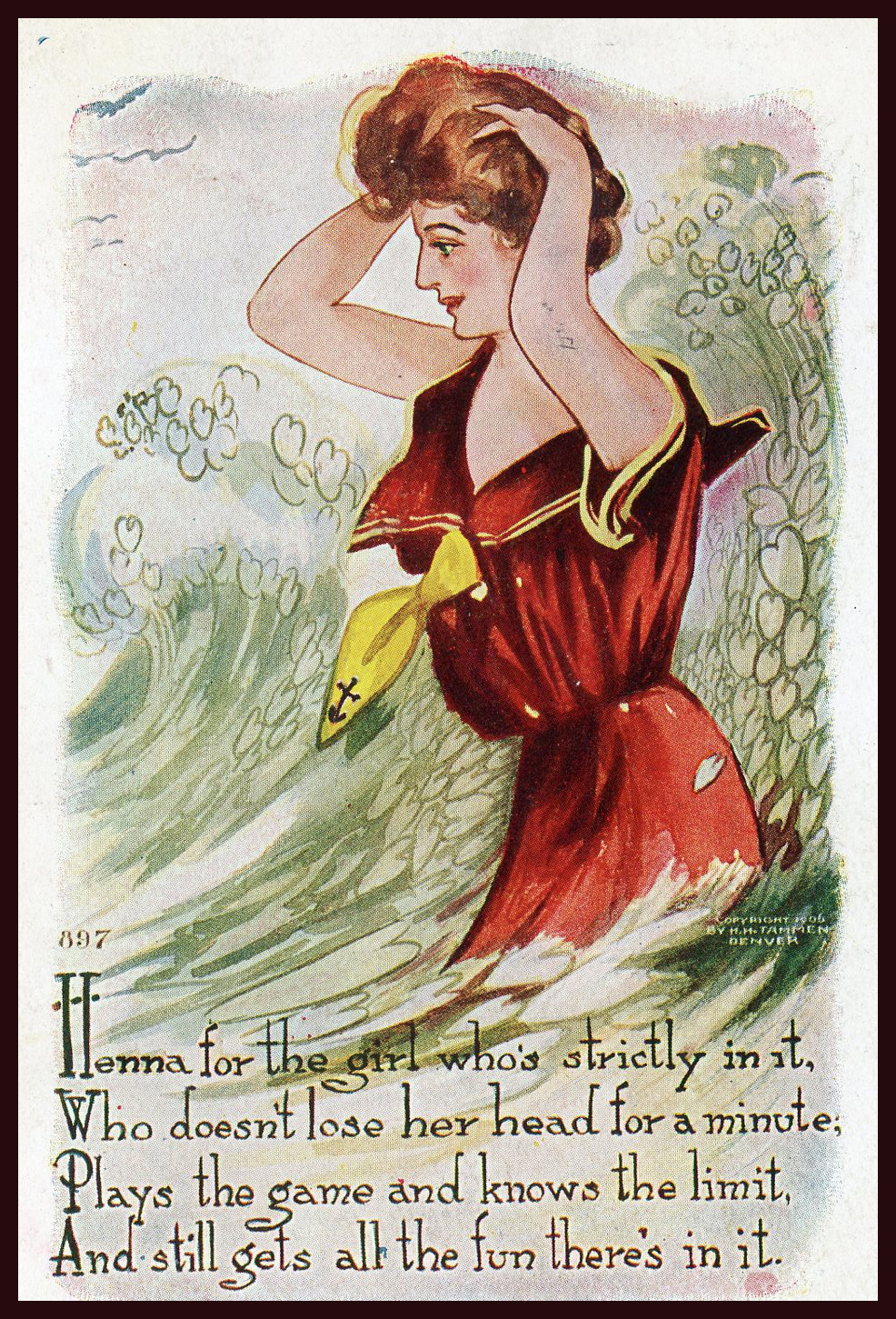
Minerals from tap water accumulate in the hair over time. They can cause the hair to feel drier and more brittle, prevent dye uptake, and affect the color. Hennaed hair will darken with mineral build-up. Cassia can react with minerals in the hair, turning the hair muddy-colored or greenish rather than golden.
Ancient Sunrise® Rainwash Mineral Treatment is great to use prior to henna treatments, and regularly to keep the hair bright and soft. Those who live in areas with hard water will notice the effect of minerals more quickly and will need to clean their hair of mineral build-up more often. All tap water contains some level of mineral content, so Rainwash is always a safe bet, no matter what type of water you have.
Rainwash comes in powder form. Mix it with distilled water until it thickens into a gel consistency. Apply throughout the hair, wrap the hair with plastic, and leave it in for 15-40 minutes. A deep cleanse will require forty minutes, while fifteen is enough if you are using the product regularly. During this time, the product is dissolving minerals out of the hair, and it is normal to notice a metallic or sulfur smell. Rinse well. Using a dab of shampoo will ensure that all of the gel and minerals are thoroughly rinsed out.
For best dye results, it is important to skip the conditioner before applying henna. As mentioned before, oils create a barrier and prevent the dye from binding properly to the hair. The glycerin and silicone compounds in conditioning products do the same.
Some people are concerned that their hair will be difficult to manage without conditioner. A vinegar rinse can help to keep the hair slippery enough to work with. Do this as the last step after using Rainwash and shampoo. Rinsing the hair with cool water can also help the hair become smoother.
Finally, people commonly ask whether to apply henna to wet or dry hair. Either way is fine; whatever makes your hair easier to separate into sections. Hair should be at least towel-dry, or the paste is apt to get thin and runny once it is on. Also, be aware that hair is more fragile and prone to stretching while wet.
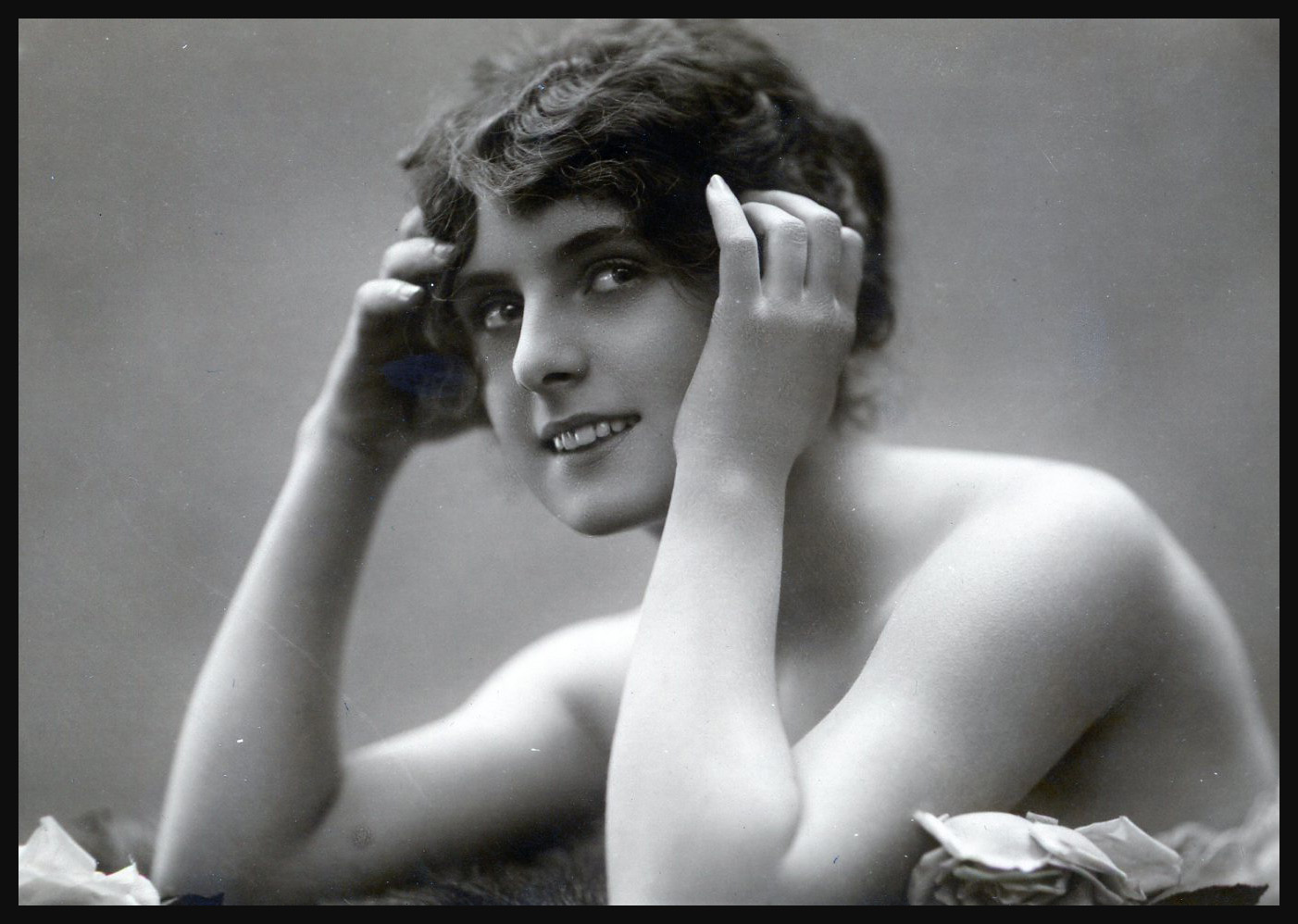
Putting all of this information together, here is the best way to prepare your hair before henna.
1. Mix and apply Ancient Sunrise® Rainwash according to the instructions.
2. After leaving the Rainwash mixture in your hair for the recommended amount of time, rinse your hair and use a detergent or clarifying shampoo.
3. For extra oily or dye-resistant hair, use a few drops of dish soap.
4. Remember not to use conditioner.
5. If skipping conditioner makes your hair unmanageable, rinse your hair with diluted vinegar and cool water to give it extra slip.
6. Dry your hair to the point where it is no longer dripping. Damp or fully dry hair is fine.
7. It is best to do all of this right before applying henna, rather than the day or evening before.
The above information applies to using henna and indigo in two separate steps, or any time when another mix is used shortly after the first one, such as in the case of missed spots or a result that is too light.
It is especially important that the hair is clean and free of oils before applying indigo. If you are applying both steps of a two-step process on the same day, simply rinse and shampoo out the henna paste, towel- or blow-dry your hair, and apply the indigo. Indigo can be applied up to 48 hours after rinsing henna; if you plan to wait, it is important to wash your hair again right before you apply indigo.
As a general rule of thumb, any time you plan to apply a plant dye mixture to your hair, it is best to have it as clean as possible immediately prior to application.
If you have any additional questions, don’t hesitate to contact Ancient Sunrise® Customer Service via phone, email, or online chat at www.mehandi.com.
The holidays are coming fast. Ancient Sunrise® and Becoming Moonlight® products from www.Mehandi.com make great gifts for a variety of people. You might know someone who has been interested in trying henna, or someone who has been a devoted henna-head for years. Maybe you have a cosmetics-lover in the family, an artist, a frequent flyer, or someone who is always busy but wants to look their best. Here are eight gift ideas to make everyone happy.
You could also share this post with loved ones (nudge, wink) to point them toward what you might want this season.
Your friend has been admiring your hair for ages, and they’re finally ready to try henna, but they don’t know where to start. Put together a sweet and simple gift bag with everything they need to begin.
If they’re not sure about their mix, start them off with a few kit samples that are closest to what they want. They can use these to conduct strand tests to help them decide on their mix. Add in a packet or two of our famous Ancient Sunrise® Rainwash treatment, some disposable gloves, hair clips, and a warm knit cap. Write a nice note offering to order their first kit and help them apply it once they’ve figured out what they want.
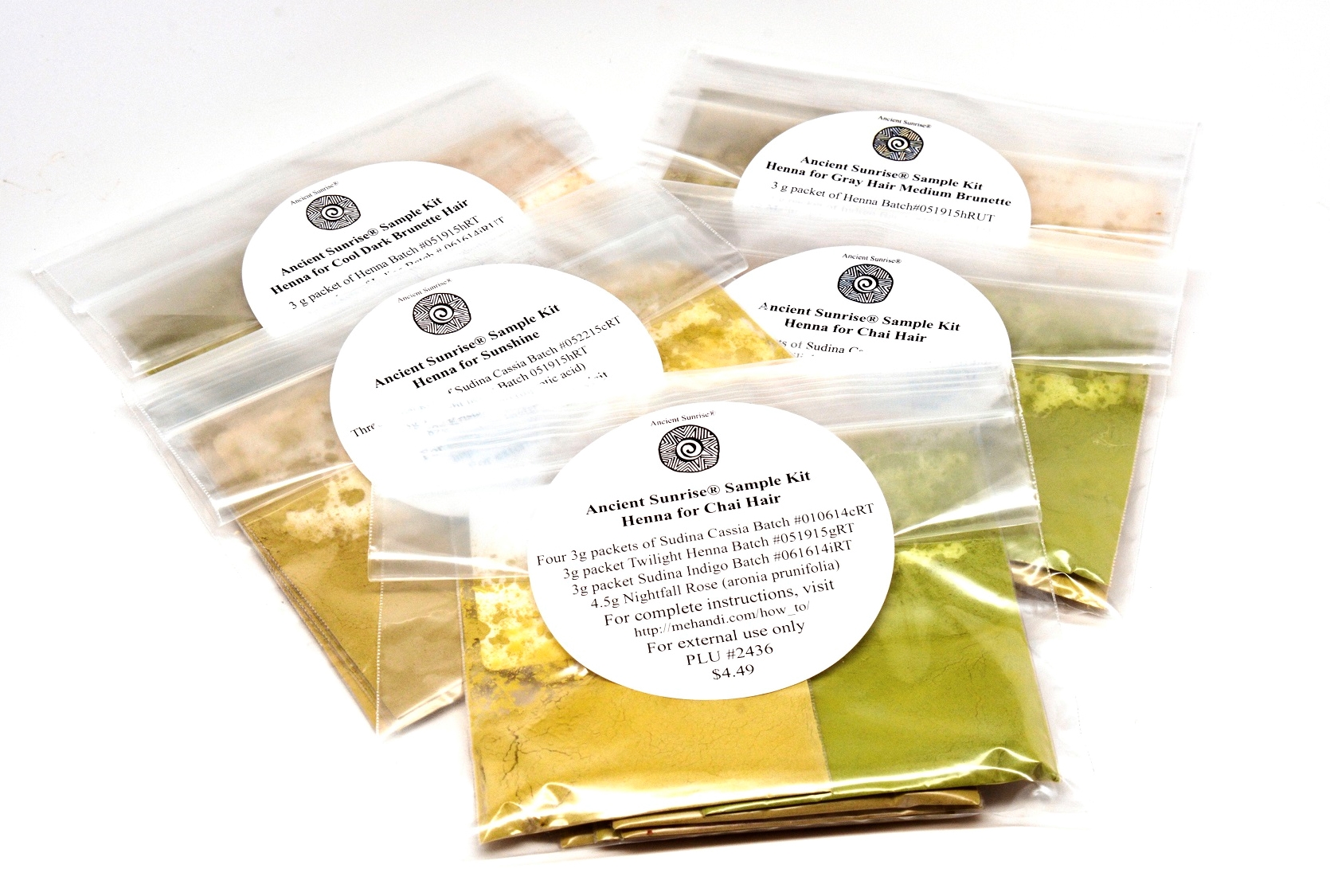
Ancient Sunrise® Zizyphus Spina Christi is a wonderful cleanser and conditioner for any hair type and color. Learn more about Ancient Sunrise® Zizyphus here.
Ancient Sunrise® Cassia adds strength and shine with minimal color change.
Spellstone hair ornaments make beautiful, unique gifts, and are 50% off with coupon code “Spellstone” until January 6th! They come in a variety of designs to fit every hair length and texture. Each design has a unique meaning. Each piece is made from ethically sourced water buffalo horn or bone.
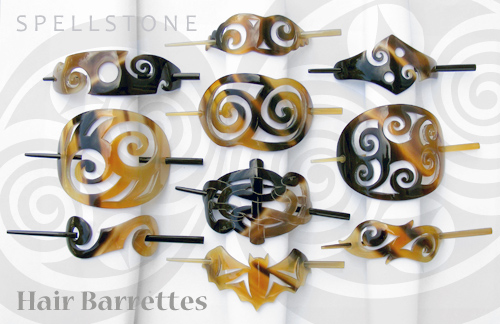
Know someone who likes to turn their henna day into a full spa day? Make them a basket of Ancient Sunrise® products to make their experience extra special.
Ancient Sunrise® Amla powder makes for a great facial mask that cleans, exfoliates, tightens, and brightens. It is high in Vitamin C which is known to brighten complexions, and has anti-microbial properties. Ancient Sunrise® Amla powder is tested for purity by an independent laboratory. Amla has many beneficial uses which you can learn about here.
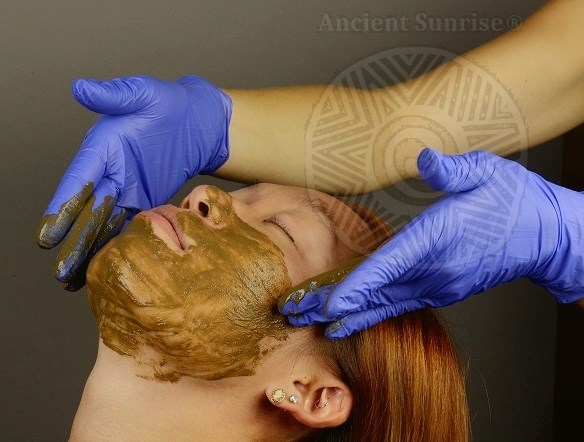
Ancient Sunrise® Henna Attar has a wonderful earthy aroma reminiscent of chocolate and tobacco with a faint, sweet floral note. Dab it on the wrists, behind the ears, or dilute it with a carrier oil. A little goes a long way. Add in a comfy robe or a candle, and this gift is a winner.
Becoming Moonlight® body art products are wonderful for those who have an artistic spirit, or those who were a unicorn in a past life.
The Gilding Kits are a great introduction for those who have not used gilding paste. They can be used to create beautiful, sparkling “white henna” patterns and more. Each kit comes with a cone of Becoming Moonlight® gilding paste, glitter, gilding powder, gems, alcohol swabs, and instructions.
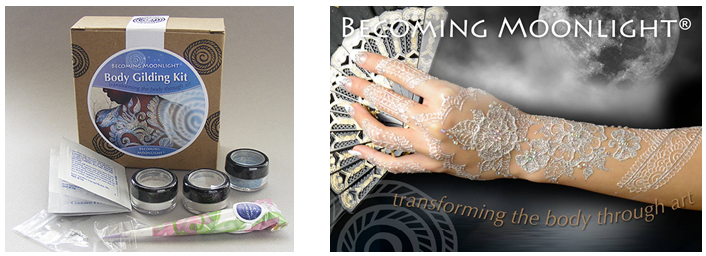
This is a great gift for teens who can’t stop drawing on themselves, and is much safer than those “white henna” tutorials online which use anything from white acrylic paint to white-out. Becoming Moonlight® gilding paste is specifically designed for body art use, and is non-toxic and latex-free. As it is flexible and water-resistant, Becoming Moonlight® gilding paste lasts up to a week or longer on the skin.
Print out the free 2018 Henna Page Calendar or one of the many free pattern books, to provide some artistic inspiration.
Becoming Moonlight® glitters, gilding powders, and gems are all body-art quality and make for great stocking-stuffers, too. The gilding powders are wonderful as eye-shadows and highlighters.
You may know someone who is always traveling, be it for work or for wanderlust. Put together a travel bag they can easily take with them wherever they go. These products are much better than those little bottles in hotel bathrooms, and won’t be a problem when going through airport security.
Ancient Sunrise® Shampoo bars are fantastic for travel. Your loved one won’t have to worry about bringing another liquid through TSA, or having a shampoo bottle leak in their luggage bag. They can even cut off small pieces rather than taking the whole bar. The shampoo bars are made from all natural ingredients, are vegan, cruelty free, and pH balanced. They leave the hair soft and moisturized; following with conditioner isn’t necessary, so that’s yet another bottle they won’t have to pack!
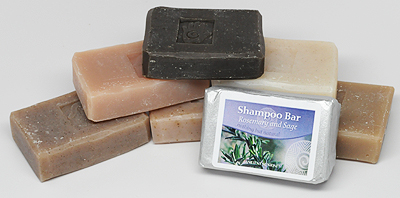
Water quality varies greatly from place to place, and hard water wreaks havoc on the hair. Luckily, Ancient Sunrise® Rainwash Treatment is easy to pack and clarifies the hair to leave it smooth, soft and manageable. It comes in both single-use packets and 50g jars (enough for about ten uses).
Ancient Sunrise® Zizyphus is a great option for those who are going to the beach. It is a natural 2-in-1 shampoo/conditioner that protects the hair from salt water and wind. It comes in a powder form which is mixed with water to form a paste. For campers, it’s safe to rinse outside or in a body of water because it does not contain anything that is harmful to the environment.
If the person in mind colors their hair with Ancient Sunrise® henna, ask them what they use, and portion it out into single-use packets that they can take with them to touch up their roots when away on long trips. Root touch-ups usually take about 50g of powder. Add a fruit acid powder into their henna/cassia so they can just add water. Just remember to keep the indigo powder separate from the rest.
You may know someone who colors their facial hair or beard with henna. As facial hair grows quickly, it can become time-consuming or annoying to do frequent touch-ups. Give the gift of convenience by mixing up a batch of henna and separating it into single-use portions which can be kept in the freezer and thawed quickly.
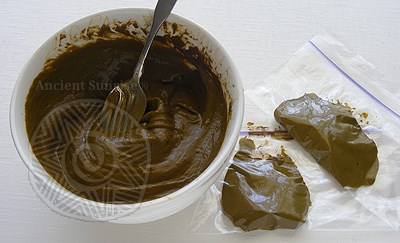
If this person uses a henna/indigo mix, measure portions of indigo powder into individual baggies so they can just thaw their henna, mix their indigo, combine, and apply. This is a great idea for root touch-ups, too.
Throw in a tinting brush or toothbrush for easy application, and a cool handkerchief so they can keep the paste warm and look like a bandit at the same time.
Shipping costs can add up quickly, especially for those henna-heads who live on the west coast, or outside of the United States. If you live closer to Ohio and have friends or relatives visiting from a far-off land, offer to order their favorite plant powders in bulk. Ancient Sunrise® products can be brought across borders without problem. If you order for the both of you, you get the benefit of a bulk discount as well.
Just make sure to account for shipping and handling times so they don’t go home without their goodies. Most orders take about 5-6 business days. Shipments within Ohio can be faster.
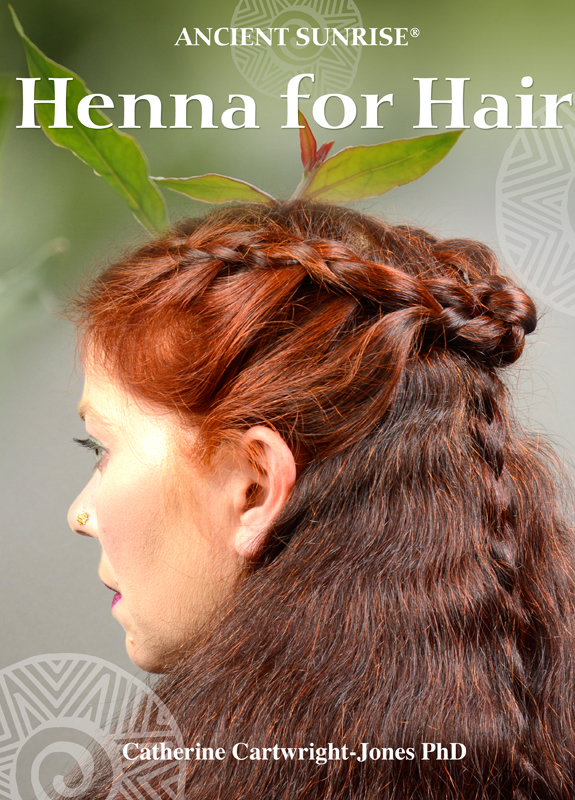
The Ancient Sunrise® Henna for Hair E-book has become something like the henna for hair bible. Many long-time henna users still visit it over and over again. The newest chapters include wonderful knowledge about the history of henna use. The best thing is, it’s free to download.
Create a unique gift by downloading the chapters onto a USB drive, and taking it to a printer to have it printed and bound. It will be a lovely addition to a library or coffee table, and very useful for when your loved-one is midway through mixing their paste and just needs to do a quick check.
When ordering your items, remember to check how long the shipping will take, to ensure your package arrives on time. Express shipping is available at extra cost if you order directly with Customer Service through phone, email, or online chat.
Office hours may change during the holidays. Liking and following our Facebook pages is the best way to keep up to date on any changes. Mehandi’s Facebook page is here, and also be sure to join the Ancient Sunrise Henna group if you haven’t already.
Indigo powder and gilding paste are affected by cold temperatures. If you live in an area whose temperatures fall below freezing, you may want to request extra insulation or express shipping to make sure your indigo stays safe.
Be sure to check the return/exchange policy here.
We wish you a wonderful holiday and hope your friends and family absolutely love their gifts.
Author: Rebecca Chou December 2017
Edited: Maria Moore September 2022